Here are the best cities near Venice in the Northern Italian region of Veneto and the main sights to see in each.
Nowadays, the famous city of Venice, Italy is the capital of the Veneto region.
In the past, it was a powerful republic that dominated large swathes of land in Northern Italy and further beyond. The cities of Venice I tell you about in this blog post were under Venetian rule for centuries. Today, they are Veneto’s main cities, they are a short distance away from Venice, and are great destinations for day trips from Venice and longer explorations in the area.
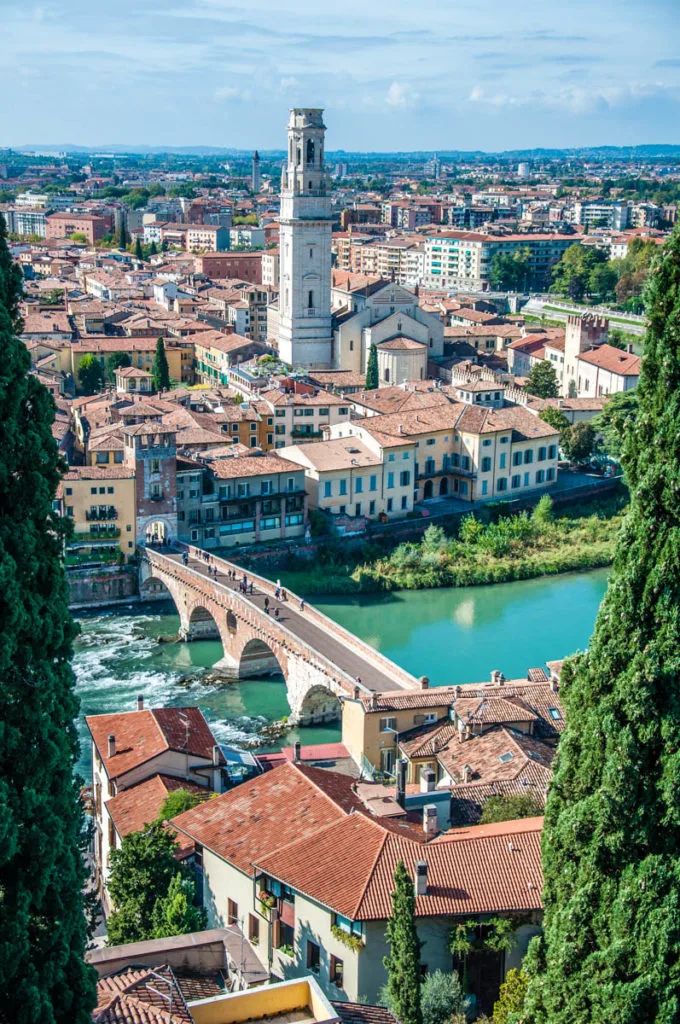
From the city of love Verona to the city of academics Padua, from the city of architecture Vicenza to the gateway to the Dolomites Belluno, Veneto has a lot to offer to couples, families, and solo travellers seeking to experience the very best of Italy in terms of history, art, culture, and nature.
This gorgeous corner in the north of Italy is rich in unique historic places, beautiful natural sights, and more art than you can see in a lifetime. Add to this happy mix the local cuisine – so different from the rest of Italy, based on Veneto’s rich agricultural heritage, and influenced by the centuries of the Venetian domination over the Mediterranean trade. And then don’t forget the lively cultural spirit of the locals with hundreds of festivals and celebrations taking place all over this Northern Italian region all throughout the year.
In a nutshell, if you are looking for great destinations to head to, the cities of Venice and Veneto are a perfect choice on so many levels.
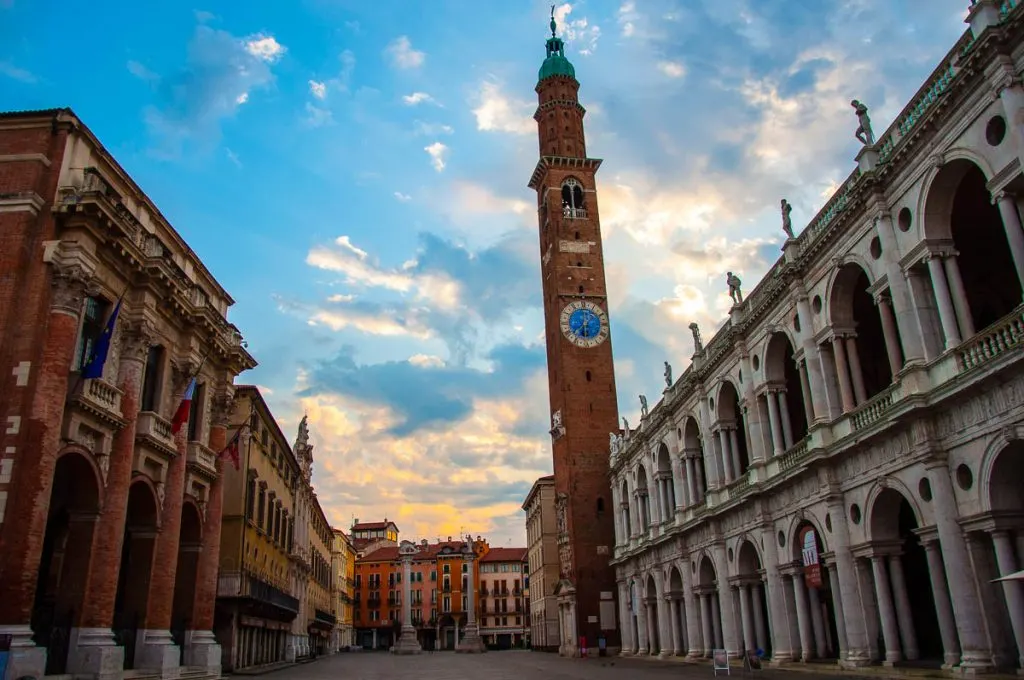
So, to make your travel planning smooth and easy, today I want to share with you the best things you can do and see in the Venetian cities and in Venice itself. Each one of them – from the tourist magnets to those off the beaten track – is worth a visit on account of its exciting landmarks, curious history, and delicious dishes.
Even better, as they all are near Venice and within a short distance from one another, you can easily visit several of the cities in Veneto within the same Italian holiday. What a great way to see the most in the shortest amount of time!
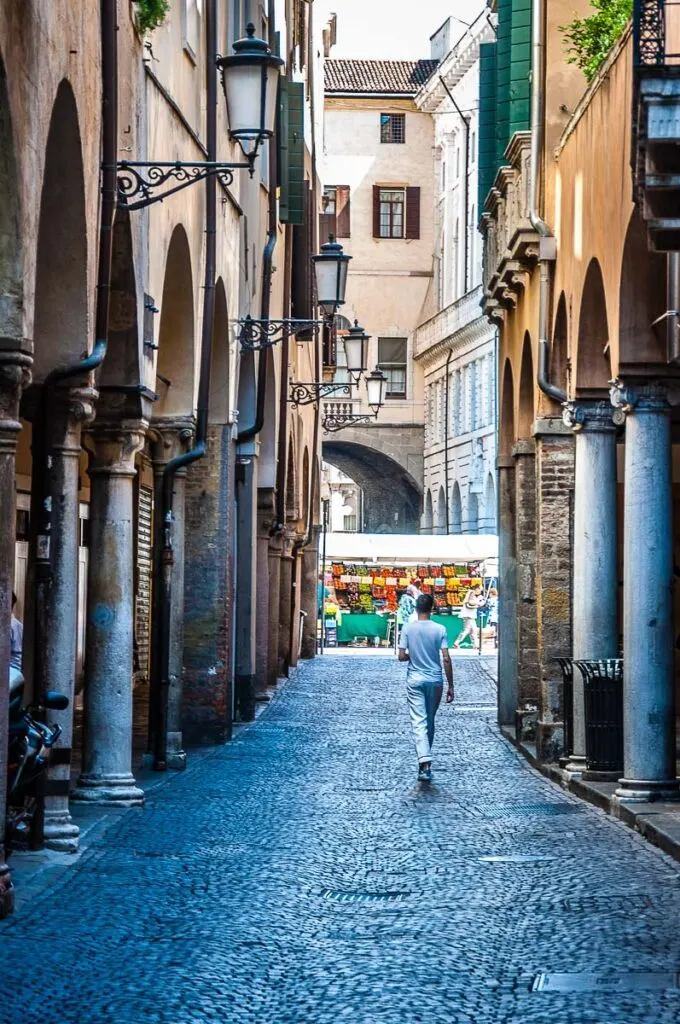
Here they are:
- Venice – the capital of the Northern Italian region of Veneto;
- Verona, Padua, Vicenza, Treviso, Rovigo, and Belluno – provincial capitals of Veneto;
- Bassano del Grappa, Chioggia, and Schio – important urban destinations in Veneto with rich history and beautiful sights.
For all that they have to offer, they are great standalone destinations to visit in Italy. Many of them are also very compact in size and are much more akin to what elsewhere may be considered to be large towns. So, you can easily explore them on foot and enjoy their highlights in a day.
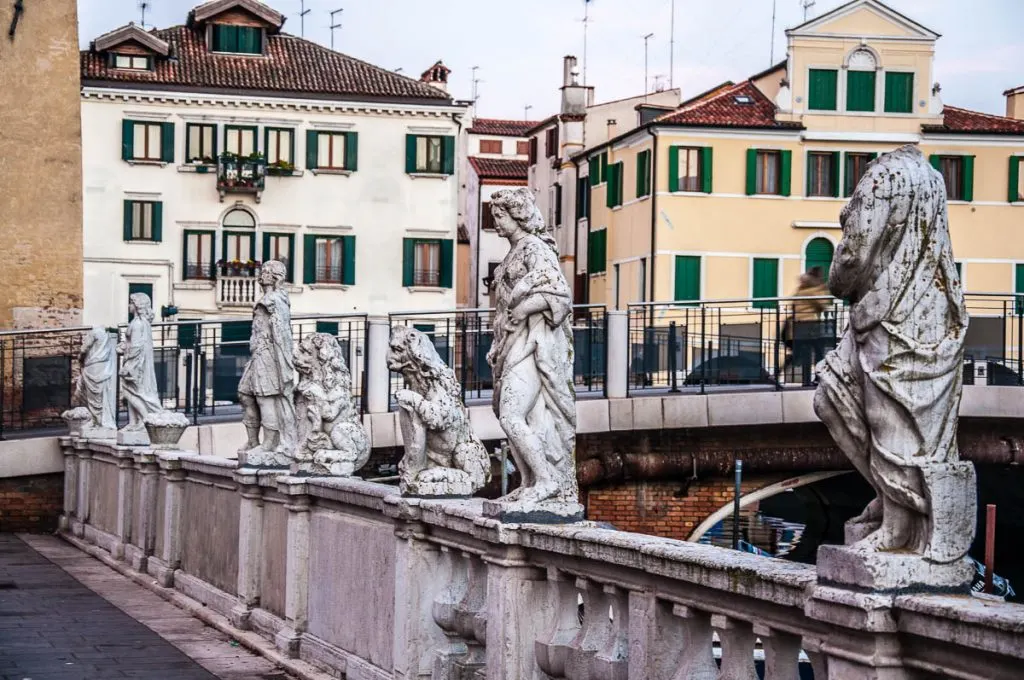
For each of these ten cities in Veneto I have included:
- a shortlist with the most important sights that can be seen in a day;
- approximate travel times by train/coach from the nearest Venetian cities;
- photos to give you an idea of what to expect;
- (where available) links to detailed and city-specific travel guides and exciting videos to help inspire your trip. The videos are hosted on my blog’s Facebook page. (If you haven’t liked it yet, I would really appreciate it if you could! Several times a week I share beautiful photos and engaging travel information on Facebook so your like will give you regular access to all this.)
Then, there is a map showing Veneto in Italy with its main cities pinned to it.
At the end of this blog post, you will find a section with practical tips about visiting the cities of Venice and Veneto in Italy. From how to travel between the different Venetian cities to where to stay here, everything is covered.
Have a look!
10 Cities of Venice and Veneto to Visit in Italy and What to See in Each (With Map, Travel Times, and Practical Tips)
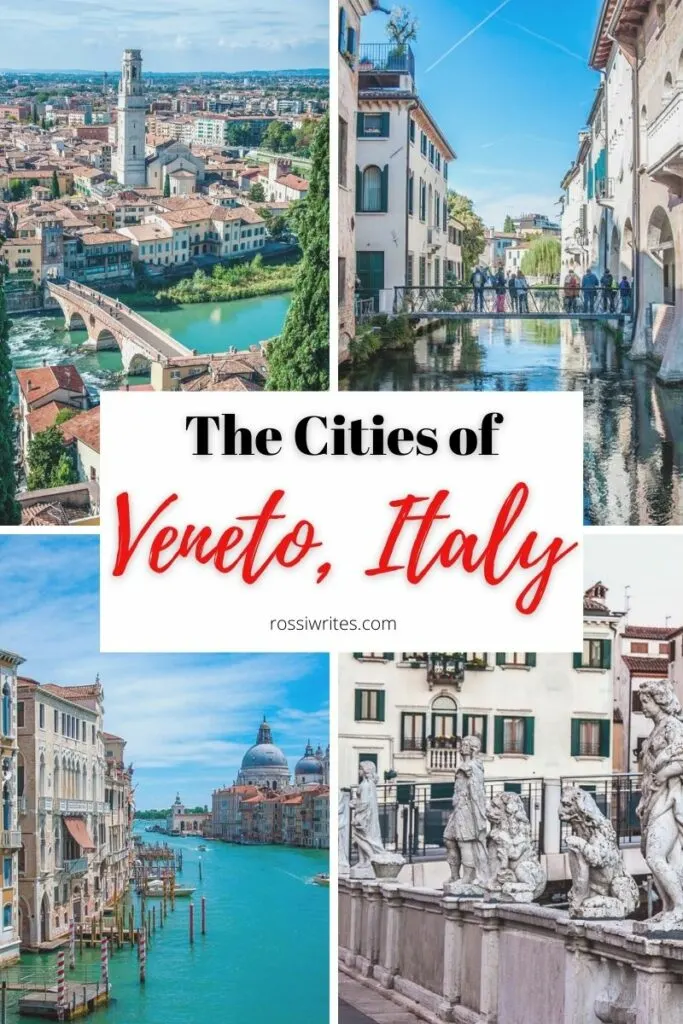
1. Venice – The Famous City of Canals
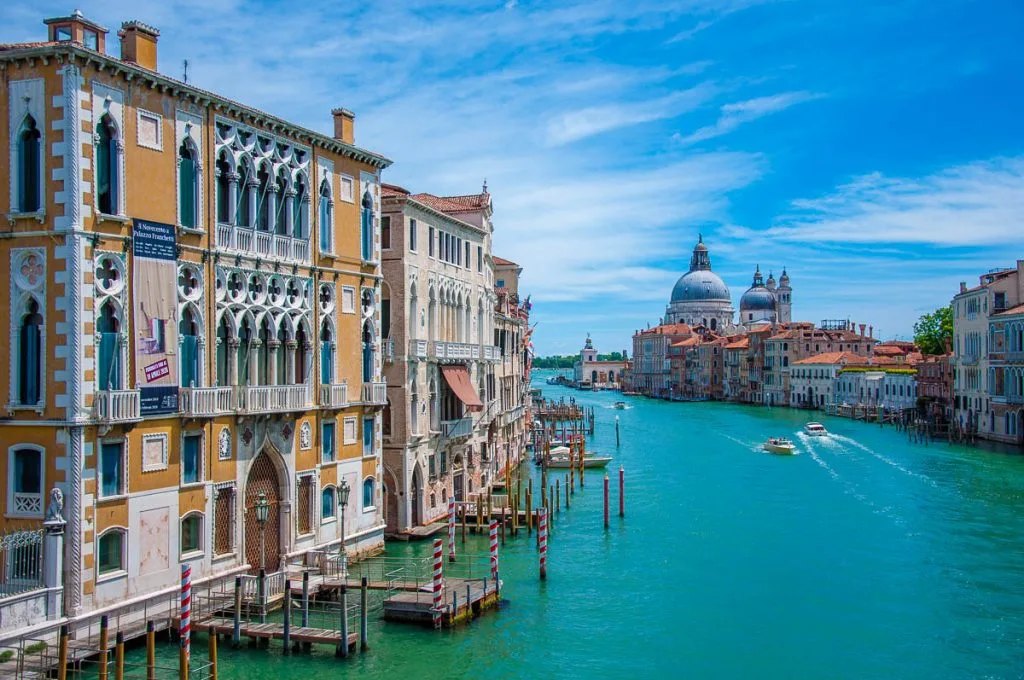
The fabled city of Venice – once the head of a powerful maritime republic and nowadays a must-see tourist magnet – is both Veneto’s capital and most important city. 30 million people head to Venice each year eager to experience its art, history, and beauty for themselves.
The historic centre of Venice – or Venezia in Italian – is built on 118 islands connected by 400 bridges in the heart of the Venetian Lagoon. There is so much to see and do here that it’s easy to become a bit overwhelmed. From major landmarks to hidden gems, Venice is rich in surprises and delights.
Just have a look at these essential tips for Venice first to find out how to have a very pleasant stay here while avoiding the suffocating crowds. Also, make sure that you bring your most comfortable shoes and get mentally prepared for lots of walking and standing on your feet.
Here are my suggestions for the best things to do in Venice, Italy:
- Grand Canal – take a vaporetto from Venezia Santa Lucia train station all the way to St. Mark’s Square. The journey down the Grand Canal is a fabulous introduction to the beauty of Venice. Along the way you will see such stunning buildings and structures as Ca’ Pesaro, Ca’ d’Oro, Rialto Bridge, Ca’ Rezzonico, Accademia Bridge, Gallerie dell’Accademia, and Basilica Santa Maria della Salute. The vaporetto (this is what they call water buses in Venice) will take you all the way down to the large expanse of water known as St. Mark’s Basin. Here you have St. Mark’s Square and the Doge’s Palace on one side and the islet of San Giorgio Maggiore on the other.
- Doge’s Palace – a visit to this splendid Gothic building of red Verona marble and white Istrian stone is a must when you are in Venice. It gives you a great insight into the power that the Republic of Venice wielded as a politial and commercial titan during its heyday. Plus, the palace is dotted with monumental pieces of art which fill you with awe.
- St. Mark’s Basilica and St. Mark’s Campanile – this is Venice’s most iconic church. It is covered with gold mosaics inside and has many must-see sights. The Pala d’Oro and St. Mark’s Quadriga being two of them. The campanile is a tall bell tower opening breathtaking views over the city of water.
- Rialto Bridge and Rialto Markets – one of Venice’s most famous sights, the elegant stone arch of Rialto Bridge straddles the Grand Canal at its narrowest point. Right next to it you can explore the Rialto markets offering an abundance of fresh produce and fresh fish.
- Museums and Landmarks – Gallerie dell’Accademia and Peggy Guggenheim’s Collection are two of Venice’s most visited sights. In addition, there are many lesser-known yet very beautiful museums and landmarks here that are great to see. For example, Fondazione Querini Stampalia, Scala Contarini del Bovolo, and Palazzo Mocenigo.
- Cicchetti – these are traditional for Venice finger foods. You will see them sold in small eateries called bacari. The locals enjoy them with a glass of wine (known as ombra in the Venetian language);
- Historical Events – Venice holds several splendid events throughout the year. If you can, try visiting for the world famous Venetian Carnival. Otherwise, the Festa del Redentore in July and the Historical Regatta in September are also great to see in person.
- Tours of Venice – if you want to experience Venice accompanied by a knowledgeable local guide, click to see the ten best tours of Venice you can book.
Venice is such a delight. A trip to the city of water can be a travel highlight to remember and cherish for years to come.
Travel Times by Train from Other Cities in Veneto: From Padua – 25-28 mins. From Treviso – 30-40 mins. From Vicenza – 45-47 mins. From Rovigo – 48 mins – 1 h 2 mins. From Bassano del Grappa – 1 h 12 mins – 1 h 17 mins. From Verona – 1 h 12 mins – 1 h 28 mins.
Train station: Venezia Santa Lucia
Where to Stay in Venice: Scalon del Doge, Hotel Moresco
Tips: The train station you need to get off at for the historic centre of Venice is Venezia Santa Lucia. It is the last stop on the train track. Don’t get off at Venezia Mestre as this is the train station of mainland Venice, i.e. the administrative and residential borough of Mestre. Click for detailed information on how to navigate Venice’s train stations.
Click for more information:
Venice: Essential Tips, Best Things to Do, Major Landmarks, Hidden Gems, How to Navigate Venice, Venice in a Day for Art Lovers, Train Stations, Nearest Airports, Best Tours, Boats in Venice, Haunted Venice, Beaches in Venice, Day Trips from Venice, Dorsoduro, Rialto Bridge, Arco del Paradiso
Venice Videos: Grand Canal, St. Mark’s Square at Carnival, St. Mark’s Square, View from Rialto Bridge, View from Accademia Bridge, Venetian gondolas, Historical Regatta, Squero di San Trovaso, Palazzo Contarini del Bovolo, Fondazione Querini Stampalia, Palazzo Grimani, Rialto Fish Market, Ca’ Macana, Festa della Madonna della Salute
2. Verona – The City of Love
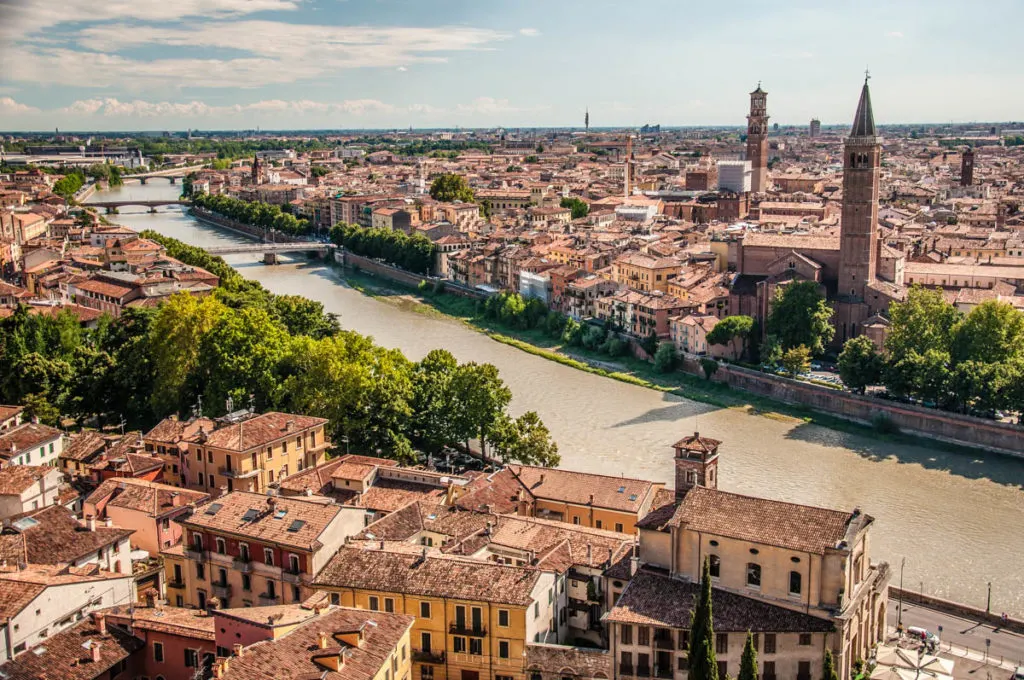
Fair Verona doesn’t need an introduction. This is, after all, the Italian city that is forever linked in our hearts with the story of Romeo and Juliet. Verona is a great destination near Venice in Italy not just because of its Shakespearean heritage though.
This Venetian city also has a rich Roman and medieval past, a worldwide known opera festival, and enough sights and places of interest to keep you busy for at least a couple of days.
Here are my suggestions for the best things to do in Verona, Italy:
- Piazza Bra – this is one of the largest squares in Italy. Here you can visit Arena di Verona – the amphitheatre that in Roman times hosted gladiator fights and nowadays is one of the finest opera venues in the world.
- Piazza delle Erbe – a beautiful square that is flanked by frescoed buildings from Verona’s Middle Ages and the Renaissance. The Baroque Palazzo Maffei presides over them all. In the centre of the square you will see the Madonna Verona Fountain which is recognised as the symbol of the city of Verona.
- Piazza dei Signori – this square is next door to Piazza delle Erbe and it’s surrounded by imposing historic buildings. A full-size statue of the Italian poet Dante stands in the middle of it. Verona’s annual Christmas market and several other important for the city festivals and events are traditionally held here.
- Scaliger Tombs – this is a group of Gothic funerary monuments honouring Verona’s medieval rulers – the fearsome Della Scala family.
- Torre dei Lamberti – built in 1172, this is the tallest tower in Verona, Italy. It opens inspiring panoramic views over the city’s red rooftops.
- Juliet’s House – outfitted with the famous balcony (which, in fact, is a sarcophagus sawed in half). Don’t just limit yourself to a quick visit of the courtyard. Instead, make sure that you tour the actual house, as it gives you a fascinating insight into life in the 13th century.
- Castelvecchio – explore this mighty medieval castle which nowadays houses a splendid art collection.
- Roman Theatre and Archaeological Museum – this splendid Roman theatre was built in the first century BC. It is still very well preserved and even used for stage performances today. Visit the adjacent Archaeological Museum if you want to learn more about Verona’s Roman past.
- Giardino Giusti – a Renaissance garden first planted in the 15th century. From its top level you can enjoy stunning views of Verona.
- Juliet’s Club – made famous by the film Letters to Juliet. The Secretaries of Juliet reply to letters sent from all over the world asking the Shakespearean heroine for advice in the matters of the heart.
There are so many museums, churches, and places of interest in Verona, that you will be spoiled for choice. The good thing is that the city centre is easily navigable on foot, so you can walk everywhere and see as much as possible within a short time frame.
Travel Times by Train from Other Cities in Veneto: From Vicenza – 26-40 mins. From Padua – 44-58 mins. From Venice – 1 h 12 mins – 1 h 28 mins.
Train staion: Verona Porta Nuova
Where to Stay in Verona: Palazzo Monga, Hotel Accademia
Tips: Consider purchasing a Verona Card. For a single, inexpensive price, it gives you access to many of Verona’s landmarks. You can also use it on the local buses.
Try the local biscuits Baci di Romeo and Baci di Giulietta (literally Romeo’s Kisses and Juliet’s Kisses). They are delicious! Romeo’s version is made with almond paste and buttercream and Juliet’s is made with hazelnut paste and chocolate cream.
They sell them in the nice patisseries around town. My favourite place to buy them is a historical pasticceria called De Rossi (no connection to me!).
Click for more information:
Verona: Best Things to Do, Verona Opera Festival, Day Trips from Verona
Verona Videos: Piazza Bra with Arena di Verona, Stage Sets of Verona Opera Festival, Juliet’s House, The Juliet Club, Traditional Patisserie, Verona’s skyline (seen from Giardino Giusti), Verona’s skyline (seen from the funicular at Castel San Pietro), Verona Marathon
3. Padua – The City of Academic Learning
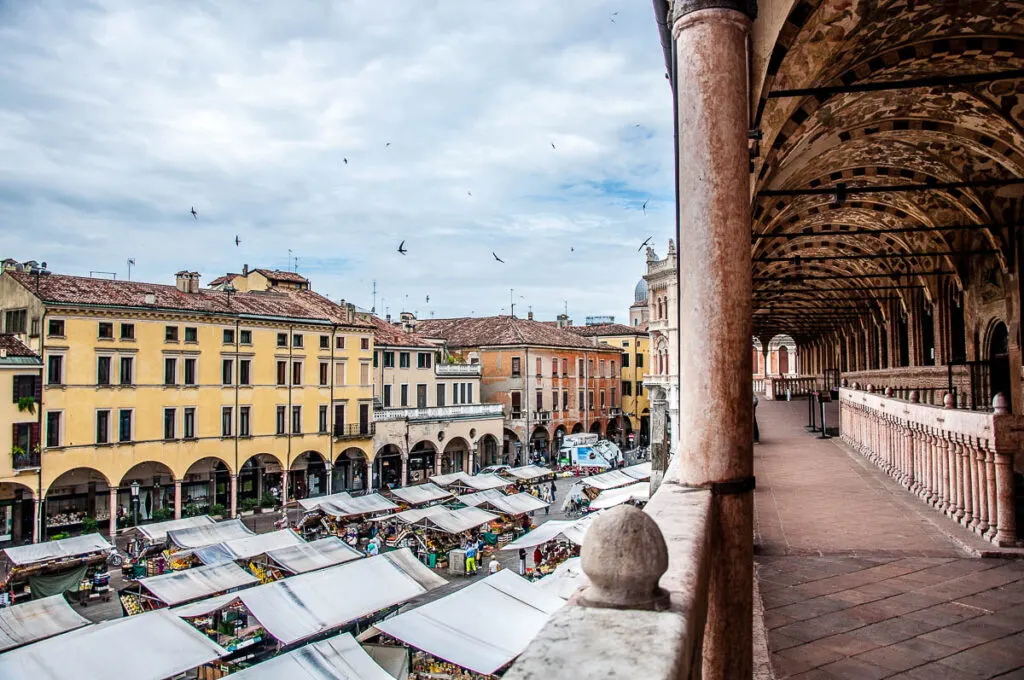
Tucked between Venice and Verona, Padua is often overlooked. Yet, this city in Veneto, Italy has a long list of must-see sights and it’s inscribed twice on the UNESCO World Heritage List.
Chiefly known as the setting of Shakespeare’s The Taming of the Shrew, Padua is rich in art, museums, churches, and historic buildings. It also has an excellent food scene.
Put at least a day aside for this gem of a Venetian city. From the world’s oldest academic botanical garden to Italy’s second-oldest University, from Italy’s largest square to an 800-year-old daily market, Padua has many aces up its sleeve.
Here are my suggestions for the best things to do in Padua, Italy:
- Scrovegni Chapel – fully frescoed by Giotto and his students at the start of the 14th century, the art in this small chapel sparked the artistic expression of the Italian Renaissance. Tickets are in demand and tied to a time slot, so book your visit in advance.
- Palazzo del Bo – the historic seat of Padua University. Founded in 1222, it is Italy’s second-oldest and the fifth-oldest University in the world. This is where Galileo Galilei taught for 18 years and where for the first time in the world, a woman – Elena Cornaro Piscopia – received a PhD degree.
- Orto Botanico – founded in 1545, this is the oldest University Botanical Garden in the world that still remains at its original spot. It’s a UNESCO World Heritage Site.
- Basilica of St Anthony of Padua – Padua’s most important religious sight and final resting place of St. Anthony – Padua’s patron.
- Palazzo della Ragione – an imposing medieval town hall with an enormous fully-frescoed hall on the top floor and a covered market on its ground level. A must-see!
- Piazza delle Erbe and Piazza della Frutta – two historic squares that flank Palazzo della Ragione on both sides. They are also the daily stage of Padua’s market that has been held at this spot for the last 800 years.
- Prato della Valle – Italy’s biggest square. It has an area of 90,000 square meters. It also has its own island that is surrounded by a canal flanked by the statues of historic personalities that left their mark on Padua.
- Caffe Pedrocchi – founded in 1772, this is one of Italy’s most legendary coffee shops. They used to call it ‘the cafe without doors’ as from 1831 (year of construction of its current grand premises) to 1916 it was open 24/7 and its doors were never closed.
With its rich academic and religious history and its many hidden corners, Padua likes to surprise its visitors at every step. The number of world-class sights that can be seen and enjoyed here is truly staggering. Plus, Padua is less than 30 minutes away from Venice on the fast regional train.
Travel Times by Train from Other Cities in Veneto: From Vicenza – 17-27 mins. From Venice – 25-27 mins. From Treviso – 38-45 mins. From Rovigo – 43-52 mins. From Verona – 44-58 mins. From Bassano del Grappa – 59 mins to 1 h 32 mins. From Belluno – 2 h – 2 h 47 mins.
Train Station: Padova
Where to Stay in Padua: Blooms Botanical Rooms, Le Camp Suite & Spa
Tips: Set some time aside to explore Padua’s hidden gems. Visit the Church of the Eremitani to see the Mantegna frescoes. Read here the amazing story of how they were destroyed during the bombings of the Second World War. Decades later they were restored with the help of advanced mathematical calculations.
Don’t miss the Baptistery right next to Padua’s Duomo. It is covered in splendid 14th-century frescoes that have quite the hypnotic effect on the viewer. It’s also part of Padua Urbs Picta – a UNESCO World Heritage Site.
Another little gem is St. Anthony’s School (next door to the Basilica of St. Anthony) which is covered in frescoes by Titian and other famous local artists.
Click for more information:
Padua: Where is Padua, 10 Reasons to Visit, Best Things to Do, 101 Facts, Day Trips from Padua, Padua in the Run-Up to Christmas, Cornaro Loggia and Odeon, 800-Year-Old Market, Astronomical Clock
Padua Videos: Prato della Valle, Basilica of St. Anthony of Padua, Scrovegni Chapel, Palazzo della Ragione, Palazzo Bo
4. Vicenza – The City of Architecture
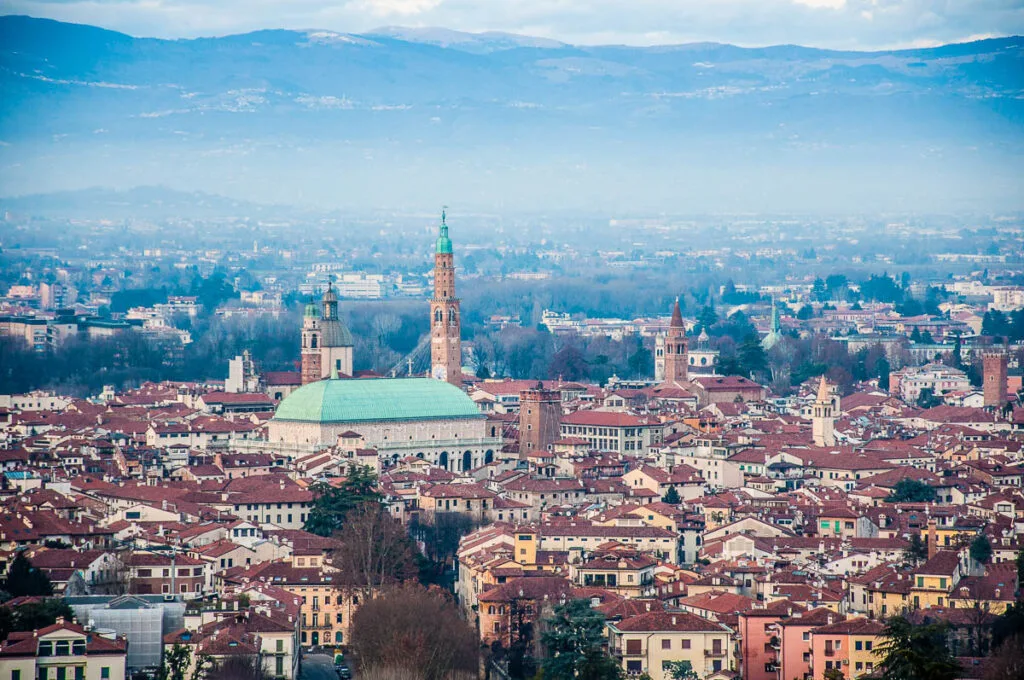
Known as the Pearl of the Renaissance, the Heart of Veneto, the City of Palladio, and the Gold Town, Vicenza lies half-way between Venice and Verona and is less than 20 mins away by train from Padua.
This city in Veneto, Italy is a creative hub of art, jewellery traditions, and one-of-a-kind events. Plus it is a veritable open-air museum of architecture. Its streets are lined with sumptuous Palladian palaces and buildings. They have inspired architectural cannons all over Europe and North America for the past 500 years. It is also thanks to them that Vicenza is inscribed on the UNESCO World Heritage List.
This is the Venetian city that I called home for six years of living in Italy. I have a lot of recommendations as to what you can see and enjoy here and I invite you not to miss the opportunity to discover Vicenza for yourself.
Here are my suggestions for the best things to do in Vicenza, Italy:
- Basilica Palladiana – this is an architectural landmark created by Andrea Palladio – one of the most influential Renaissance architects. Palladio designed many of Vicenza’s palaces and villas. His Basilica was never a church as it is sometimes thought. Instead, it used to house the town hall and it was named basilica reviving the Ancient Roman meaning of the term, i.e. a large public building with many different functions. Nowadays, the Basilica Palladiana is a venue for important temporary exhibitions. On its ground floor, you will discover some of Vicenza’s oldest jewellery shops. The Basilica’s top-level terrace is regularly open for visits and it allows you to enjoy an unparalleled view of the city of Vicenza in Veneto.
- Piazza dei Signori – Vicenza’s gorgeous central square is steeped in history and hosts some of the city’s most impressive Palladian buildings.
- Church of St. Mary of Mount Berico – this is one of Italy’s most important sanctuaries dedicated to the Virgin Mary. It stands on top of Mount Berico next to Vicenza’s historic centre. In the 15th century, the city was ravished by a terrible plague. They say that the Virgin Mary appeared twice to a peasant girl on Mount Berico and promised to stop the outbreak of the dicease if the city would build her a church at that spot.
- Teatro Olimpico – this is the world’s first indoor theatre in masonry. Like most notable buildings in Vicenza, it was designed by Andrea Palladio. Inside it, you can also see the world’s oldest surviving stage set still in use today.
- Church of Santa Corona – the church was originally built in the 13th century to house a Holy Thorn from Christ’s Crown of Thorns. For security reasons, nowadays the Holy Thorn Reliquary is shown to the public only on Easter. The rest of the time it is kept in the nearby Diocesan Museum. The church itself is very beautiful and has a rich collection of priceless works of art. Among them are paintings by Giovanni Bellini and Paolo Veronese. Here you can also visit the final resting place of Luigi da Porto – a nobleman from Vicenza and the original author of the tragic love story of Romeo and Juliet.
- Palladio Museum – here you can learn about Andrea Palladio, his life, and his architecture. Models of Palladio’s buildings in Vicenza and Veneto give you a good idea of the scope of his work. Temporary art exhibitions are also held here.
- Civic Art Gallery of Palazzo Chiericati – discover a beautiful collection of paintings, sculptures, and applied arts from the 13th to the 20th centuries. It’s housed in a beautiful Palladian palace.
- Gallerie d’Italia at Palazzo Leoni Montanari – a remarkable art museum housed in an elegant frescoed palace.
- Jewellery Museum – this is the first museum dedicated to jewellery in Italy. The jewels exhibited here change every two years.
- Jewellery Shops – expect to see many jewellery shops all over Vicenza as this Venetian city is one of Italy’s most important jewellery-making centres.
For all that it has to offer, Vicenza keeps itself off the trodden tourist track. This makes it all the lovelier to explore and all the more peaceful to enjoy. If you are an architecture aficionado or are looking for that gem of an Italian city that has it all and it’s crowd-free, come to Vicenza for a day or more.
Travel Times by Train from Other Cities in Veneto: From Padua – 17-27 mins. From Verona – 26-40 mins. From Venice – 45-47 mins. From Schio – 42 mins. From Treviso – 1 h 2 mins – 1 h 20 mins. From Bassano del Grappa – 1h 6 mins.
Train Station: Vicenza
Where to Stay in Vicenza: Relais Santa Corona, B&B Portico Rosso, Palazzo Valmarana Braga
Tips: You may wonder why there is a mulberry tree in the courtyard of the Palladio Museum in Vicenza, Italy. The surprising answer is that the humble mulberry tree facilitated the growth of Vicenza to the point that the city became a famous centre of Renaissance architecture and art.
Mulberry leaves mean food for silkworms and silkworms mean silk. The production of silk fabrics in Vicenza in the 16th and the 17th centuries was such that the city, in spite of its small size, quickly amassed unimaginable riches which the local textile merchants promptly invested in sumptuous palaces and splendid collections of art.
Baccala’ all vicentina is Vicenza’s prized local dish. It’s made by soaking in milk dried stockfish from the Lofoten islands in Norway. The rehydrated cod is then cooked over many hours and served on a bed of polenta.
Click for more information:
Vicenza: Best Things to Do, The Beauty of Vicenza, Vicenza in the Snow, Day Trips from Vicenza, Nearby Nature Sights, Chocolate Festival in Vicenza, The Oldest Patisserie in Vicenza, Flower Market, Teatro Olimpico, The Hanging Gardens
Vicenza Videos: Teatro Olimpico, Christmas Lights, Chapel of the Virgin of Rosario, Palladio Museum, Giro della Rua, Terrace of the Basilica Palladiana, Parco Querini Covered in Snow
5. Treviso – The City of Prosecco and Tiramisu
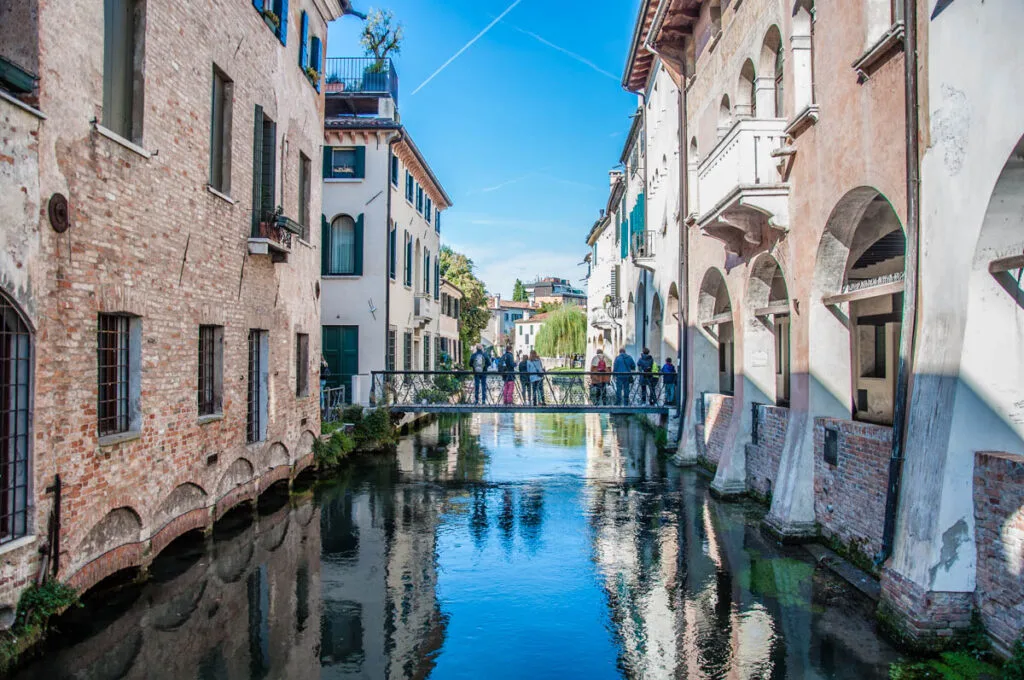
People usually fly into Treviso’s low-cost airport and then head straight to either Venice or Verona, completely bypassing this very pretty city in Veneto, Italy. Don’t make the same mistake!
With its breathtaking frescoed buildings, mighty defensive walls, long canals, stone bridges, and historic cobbled streets, the city of Treviso guarantees a day of exciting exploration.
Here are my suggestions for the best things to do in Treviso, Italy:
- Piazza dei Signori – this is Treviso’s expansive main square. It’s flanked by the following historic buildings: Palazzo del Podesta with the 13th-century Civic Tower, the gothic Palazzo dei Trecento (which was bombed in 1944 by the Allied Forces), and Palazzo Pretorio with its 17th-century facade.
- Loggia dei Cavalieri – you will find this very elegant structure in the heart of the old town. Covered with faded frescoes on the inside, it is my favourite sight in Treviso. The loggia dates back to the 13th century. It was built to serve the local nobility as a place for meetings, conversations, and games.
- Civic Museum Santa Caterina and Civic Museum Luigi Bailo – two splendid museums where you can easily spend hours admiring the many archaeological artifacts and priceless works of art. Temporary art exhibitions are often held here, too. They add to Treviso’s vibrant cultural life.
- Gallerie delle Prigioni – pop into this former prison to experience one of Italy’s foremost art spaces dedicated to contemporary culture. Gallerie delle Prigioni organises temporary exhibitions, new art commissions, and educational programmes.
- City Walls and Gates – go for a leisurely walk along Treviso’s centuries-old defensive walls that keep the city’s historic centre in their tight embrace. The gates leading in and out of the old town are particularly impressive.
- Duomo di San Pietro – this is Treviso’s seven-domed cathedral. Here you can admire masterpieces by Titian and Pordenone. You can also visit the very atmospheric crypt housing the relics of San Liberale – the city’s Patron Saint.
- Church of St. Francis (Chiesa di San Francesco) – a prime example of the late Romanesque/early Gothic style, this church has important frescos from the 13th century. Inside it are also the tombs of Petrarch’s daughter Francesca and Dante’s son Pietro. After the Fall of the Republic of Venice in 1797, the church was used as a stable and storeroom first by Napoleon’s army and then by the Austrian troops.
- Church of San Nicolo’ – this is Treviso’s largest church (it exceeds in size the city’s cathedral). It was built in the 14th century thanks to a large donation by Pope Benedict XI – himself a native of Treviso. The church stands out with its many frescoes. Here you can see the earliest depiction in a work of art of spectacles (eyeglasses) and a magnifying glass in Europe.
- La Pescheria – a small river island where the town’s fish market is held.
Treviso’s many excellent coffee houses and patisseries add greatly to its charm. Make sure to spend a quiet moment of relaxation in at least one of them. Enjoying a spot of people-watching while sipping a cup of proper Italian coffee equals finding out for yourself the true meaning of the Italian concept of dolce far niente (it’s sweet to do nothing).
Treviso is a great destination for a city break in Northern Italy, so give yourself a chance to experience it first hand.
Travel Times by Train from Other Cities in Veneto: From Venice – 30-40 mins. From Padua – 38-45 mins. From Bassano del Grappa – 1 h 1 min – 1 h 17 mins. From Vicenza – 1 h 2 mins – 1 h 20 mins. From Belluno – 1 h 24 mins – 1 h 51 mins.
Train Station: Treviso Centrale
Where to Stay in Treviso: B&B Castelmenardo39, B&B Villa Romano
Tips: Treviso is the birthplace of a dessert, a vegetable, and a drink all three of which make life so much more delicious:
- The first one is tiramisu – that glorious dessert made with coffee- and marsala-dipped ladyfingers which are then layered with mascarpone beaten with raw eggs and dusted with bitter cocoa. Truly, my favourite Italian delight!
- The second one is the radicchio rosso – also called Italian chicory in English. Its bitter taste complements greatly any fresh salad. It is very tasty grilled and added to pasta dishes, too.
- The third one is prosecco – the Italian sparkling wine which nowadays is incredibly popular all over the world.
6. Rovigo – The City of Roses
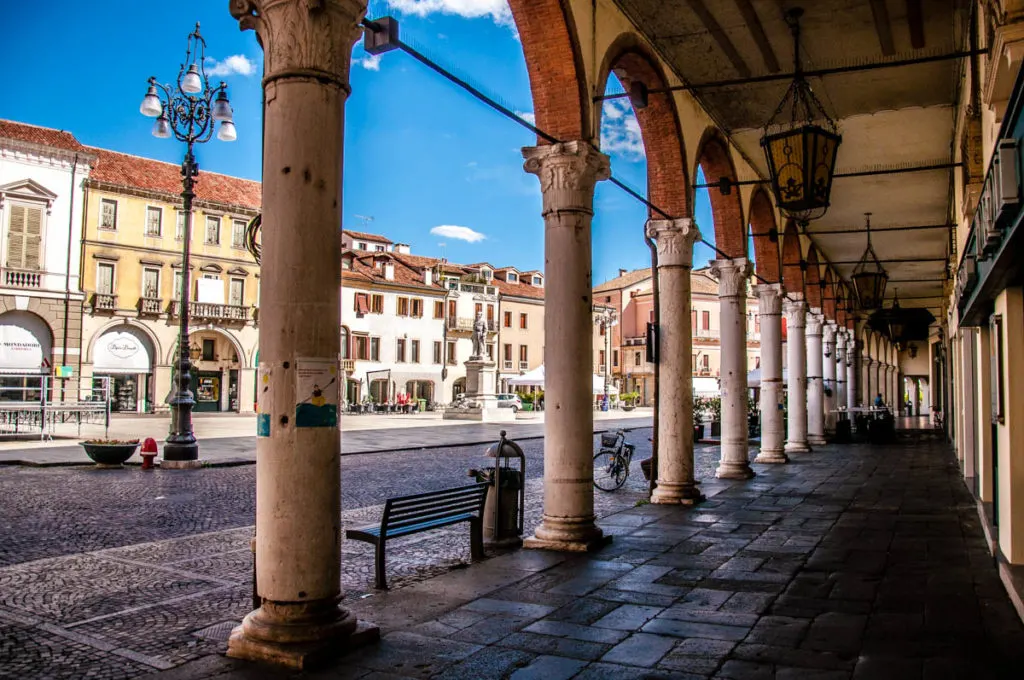
Rovigo is a city in Veneto that is little known outside of Italy. Yet, it makes for a great day trip from Venice, so consider putting it on your travel wish list.
With a compact and very walkable historic centre, Rovigo has a nice selection of galleries and museums in addition to some splendid churches where you can admire gorgeous frescoes.
By the way, the city’s name – Rovigo – is of Greek origin. It comes from the word rhodon meaning ‘rose’. Hence, Rovigo is known as the City of Roses.
Here are my suggestions for the best things to do in Rovigo, Italy:
- Torre Dona’ and Torre Grimani– imposing brick towers that are the only remnants of Rovigo’s destroyed medieval castle. Torre Dona’ is one of Italy’s tallest medieval towers.
- Piazza Vittorio Emanuele II – this elegant square is Rovigo’s beating heart. Come here to admire the architecture of the buildings that surround it and to catch a city-wide event.
- Rovigo Cathedral – this is an imposing building with a story that spans more than ten centuries.
- La Rotonda Church (also known as the Church of the Madonna del Soccorso) – it was designed by a pupil of the great architect Andrea Palladio to house a miraculous image of the Madonna with Child carrying a rose. The church’s interior is covered with 17th-century frescos.
- Palazzo Roverella and Palazzo Roncale – two Renaissance palaces in Rovigo housing rich collections of art and archaeological artifacts. Important temporary exhibitions are often held here. Palazzo Roverella also houses the Pinacoteca dei Concordi – an art gallery with original paintings by Giovanni Bellini, Palma the Elder, and Tiepolo.
For all the splendour of its historic centre, Rovigo is a small and quiet place that goes completely still during the hours of the traditional Italian riposo. A visit to this Venetian city – albeit for a couple of hours – makes for a nice and relaxing break after the hubbub of the region’s larger cities like Venice, Padua, and Verona.
Travel Times by Train from Other Cities in Veneto: From Padua – 18-55 mins. From Venice – 48 mins – 1 h 7 mins. From Vicenza – 1 h 9 mins – 1 h 39 mins. From Chioggia – 1 h 10 mins. From Treviso – 1 h 12 mins – 1 h 35 mins. From Verona – from 1 h 42 mins.
Train Station: Rovigo
Where to Stay in Rovigo: Alloggio Corte Benetti, Best Western Hotel Cristallo
Tips: Rovigo is the entry point for trips to the Delta of the river Po. Po is the longest river in Italy and its delta is a great place for active and beach tourism. You can canoe, cycle, bird-watch, go on boat trips or simply relax on the beach. Flocks of pink flamingoes live in the delta and are a delight to see and photograph. A lovely place to visit here is the Coastal Botanical Garden of Porto Caleri.
7. Chioggia – The City of Fresh Seafood
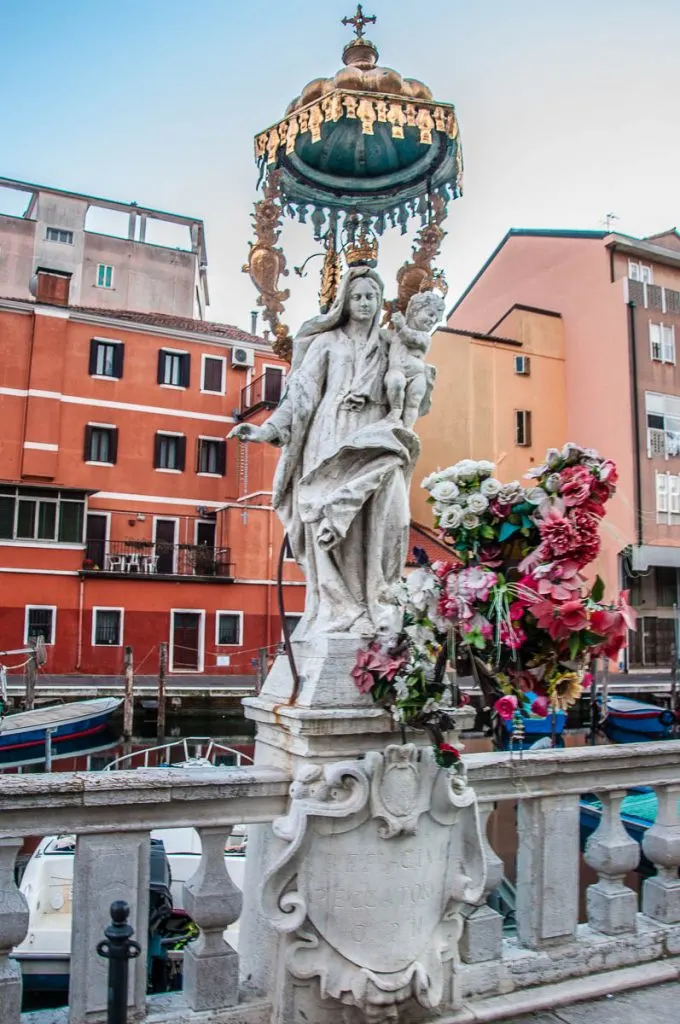
Chioggia is like a mini Venice but without the suffocating tourist crowds.
Built on islands at the southern end of the Venetian Lagoon, Chioggia is connected to the mainland by a long bridge. Canals full of boats crisscross the city. Pastel houses draped with Italy’s most photogenic clotheslines line the streets.
Just walking around feels like a real treat. You pass by many churches full of priceless works of art, small restaurants serving the freshest seafood, and everywhere you look picturesque views open in front of your eyes.
Here are my suggestions for the best things to do in Chioggia, Italy:
- Boat trip – take a tour boat for a fun ride around Chioggia in the Venetian Lagoon. Regular boat tours run through the day taking you close to several sights of historic and cultural value in the lagoon.
- Wholesale Fish Market and Retail Fish Market – Chioggia is one of the biggest and oldest fishing ports in Italy. Its wholesale and retail fish markets are lively places where tons of fresh seafood are sold daily. Make sure that you check the opening times in advance to make sure you are there at the right time.
- Bell Tower of Sant’Andrea and Clock Tower Museum – Chioggia claims to have the world’s oldest clock. See it on the facade of the 30-meter high Bell Tower of Sant’Andrea. Then visit the Clock Tower Museum inside the bell tower to see the clock’s mechanism and to learn its fascinating story.
- Museum of Southern Lagoon – this is an ethnographic and archaeological museum tracing the history of Chioggia throughout the centuries.
- Museum of Adriatic Zoology – here you can see the most important historical collection of marine animals from the Adriatic Sea.
- Duomo di Santa Maria Assunta – Chioggia’s main church.
- Refugium Peccatorum (also known as Sagraeto) – A statue of the Virgin Mary holding the Infant Jesus underneath a golden dome. It stands at Piazzale Perotolo just outside Chioggia’s Duomo. Refugium Peccatorum is a Roman Catholic title of the Virgin Mary. It means Refuge for Sinners. In the past, those condemned to death in Chioggia were allowed to stop in front of this statue of the Virgin and pray for their souls on the way to the scaffold.
- Porta di Santa Maria (also known as Porta Garibaldi) – an early 16th-century gate that in the past provided the only entry point into Chioggia.
- Corso del Popolo – Chioggia’s main artery. This is a wide and beautiful street that is lined with shops, restaurants, palaces, and churches.
- Ponte Vigo – the prettiest bridge in Chioggia stands over Canal Vena – the city’s most important canal – and it affords beautiful views over the Venetian Lagoon. From the adjacent to the bridge Piazzetta Vigo, you can get a tour boat for a fun trip around Chioggia and a ferry to the nearby island of Pellestrina.
- Sottomarina – a lively suburb of Chioggia with a sandy beach that is 10 km long and up to 300 m wide. The sand is rich in augite, quartz, silicates, and micaceous elements making the beach ideal for sand bathing treatments.
Chioggia will give you a good idea of what Venice would have been like today had it not become a maritime and commercial powerhouse centuries ago. This city in Veneto is full of character, easy to navigate, and with tons of fresh seafood. There are huge beaches within a very close reach, and, above all, there are no maddening crowds.
In Chioggia, you can take it easy and observe the locals at what they have been doing for centuries: fishing and lacemaking. All in all, it’s a great destination for a city break or a day trip in this corner of Italy.
Travel Times by Train from Other Cities in Veneto: From Rovigo – 1 h 10 mins. From Padua – 2 h 10 mins.
Train Station: Chioggia
Travel Times by Bus: From Padua – 1 h 6 mins by coach E005-V/E005-Z to Chioggia and from 1 h 15 mins by coach E005-V/E005-Z to Sottomarina. The coach line is operated by BusItalia Veneto. The coaches leave from Autostazione BusItalia (Viale della Pace 1, 35131, Padua) which is two minutes away from Padua’s train station.
N.B.: You can also travel by bus and ferry to Chioggia from Venice. First, you will need to make your way to the island of Lido where you need to catch bus 11 to the island of Pellestrina. Once you reach the last bus stop at Pellestrina Cimitero, you need to catch a ferry for the 25-minute ride to Chioggia.
Where to Stay in Chioggia: Fisherman’s House, Hotel Grande Italia
Tips: In June every year, Chioggia stages the Palio della Marciliana – a reenactment inspired by the city’s 14th-century history. Hundreds of people, dressed in lavish costumes, take over the city streets. There are noble ladies, knights, musicians, and craftsmen. There are ancient games, balls, and parades. Chioggia re-lives its glorious past when it was rivalling Venice in splendour and riches.
Click for more information:
Chioggia: 10 Reasons to Visit
Chioggia Video: Traditional Lacemaking
8. Bassano del Grappa – The City of Grappa
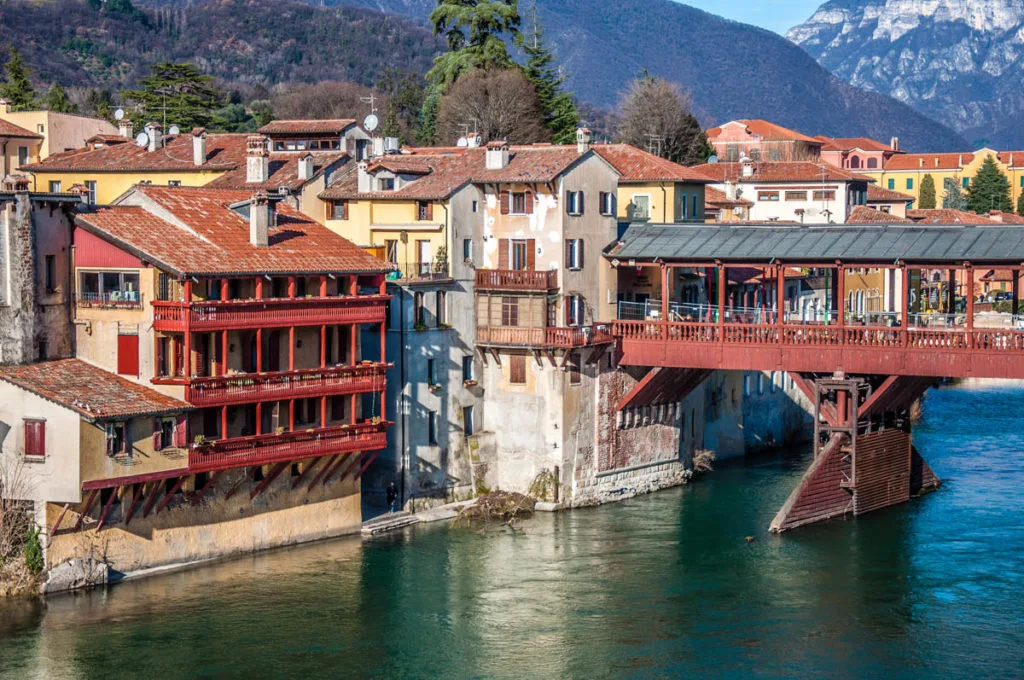
Bassano del Grappa is a picturesque city on the shores of the crystal clear river Brenta. The Venetian Prealps serve as its dramatic backdrop. Founded in the 2nd century BC, today Bassano stands out with its medieval and Venetian architecture.
Here you will find the remains of a medieval castle (used for opera performances each summer), fortified city walls, lovely cobbled piazzas, and many old buildings with faded frescoes on their facades. Winged lions (the symbol of the Republic of Venice) can be spotted all over the city’s historic centre.
Bassano is well known as a centre of production of grappa – a potent alcoholic drink made of grapes. It is often assumed that this Venetian city owes the second part of its name to the drink. Instead, Bassano was named del Grappa in 1928 to commemorate the soldiers who lost their lives in the decisive battles that were fought on the nearby Mount Grappa during the First World War.
Here are my suggestions for the best things to do in Bassano del Grappa, Italy:
- Ponte degli Alpini – a wooden covered bridge straddling the river Brenta. A bridge has stood in the same place since the Middle Ages. It was destroyed several times. In 1569, the renowned architect Andrea Palladio rebuilt the bridge giving it its current magnificent shape. The bridge’s tumultuous history didn’t stop there though. In the centuries that followed, it was destroyed again and again in wars and force major events. The last time this happened was in 1945. Palladio’s original designs were followed every time that the bridge was erected again.
- Duomo di Santa Maria in Colle – Bassano’s cathedral was originally built around the year 998 and its imposing body is still a wonder to behold.
- Piazza della Liberta’ and Piazza Garibaldi – these are Bassano del Grappa’s beautiful main squares. At Piazza della Liberta’ don’t miss the 15th-century Loggia del Comune with the splendid astronomical clock on its facade. You can go up the steps and walk inside the loggia free of charge for a great view of the square below.
- Civic Museum – housed in a former Franciscan convent, the Civic Museum of Bassano del Grappa has an archaeological collection, a medieval section, and a number of priceless artworks by the likes of Canova and father and son Tiepolo. Also here you can explore a whole room dedicated to the art of Jacopo del Ponte – also known as Jacopo Bassano – the city’s most famous Renaissance painter. The adjacent cloister holds a lapidarium and it’s also used for contemporary art installations.
- Church of St. Francis – an impressive 12th-century church next door to the Civic Museum. It has a 14th-century crucifix among several other works of art.
- Palazzo Bonaguro – this is where the Natural History section of Bassano’s Civic Museums is housed.
- Palazzo Sturm – a lovely historic building which houses two must-see museums.
- Poli Grappa Museum – here you can learn all about the potent Italian drink grappa and see how it is made.
- Hemingway and the Great War Museum – after being wounded in the First World War, the great writer Ernest Hemingway spent three months in Bassano del Grappa. The villa where he stayed has been turned into a museum.
Bassano del Grappa is the perfect destination for a day trip or a longer stay in Veneto, Italy. Little-known by the mass tourist yet so easy to fall in love with, this city has a lot to offer in terms of history, nature, culture, and art.
Travel Times by Train from Other Cities in Veneto: From Padua – 59 mins to 1 h 32 mins. From Treviso – 1 h 1 min – 1 h 17 mins. From Vicenza – 1h 6 mins. From Venice – 1 h 12 mins – 1 h 17 mins. From Belluno – 2 h – 2 h 19 mins.
Train Station: Bassano del Grappa
Where to Stay in Bassano del Grappa: Marinali Rooms, Hotel Al Castello, Terraglio Rooms
Tips: Bassano del Grappa is particularly famous for the locally made ceramics. There are several shops selling wonderful and whimsical ceramic pieces produced by small family-owned workshops.
Stock up on hand-painted cups, plates, terrines, and bowls in order to take a piece of Italy with you home. Alternatively, visit the Ceramics Museum G. Roi in Palazzo Sturm to learn more about the tradition of ceramics in Bassano del Grappa, Veneto.
9. Schio – The City of Industrial Archaeology
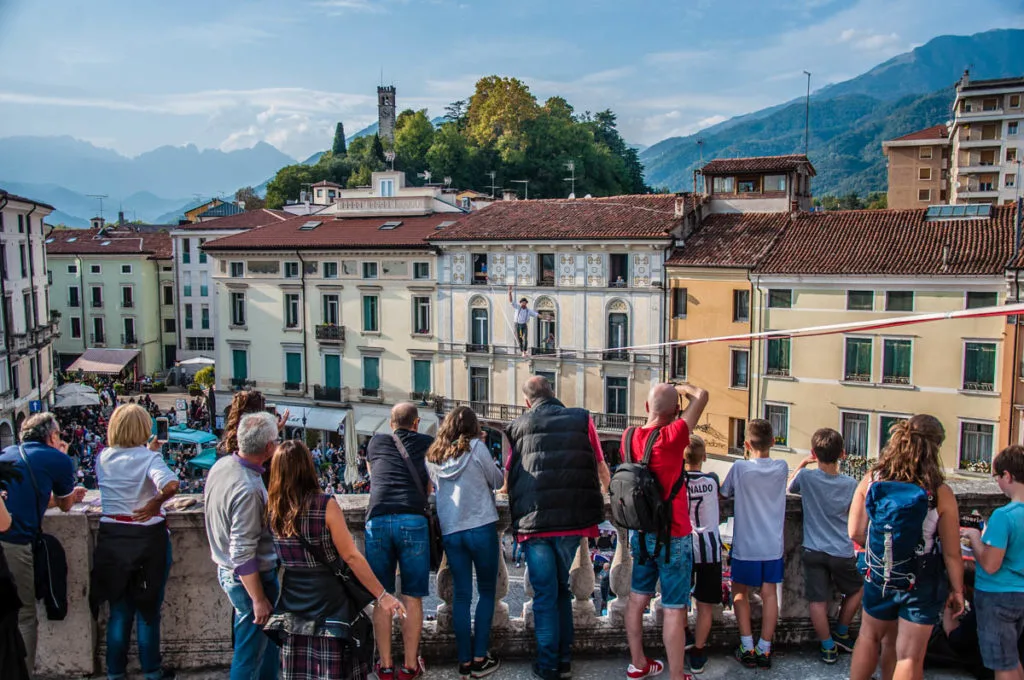
Here is a Venetian city that not many have heard of beyond the confines of Veneto and Italy. Yet, Schio is a place with a very interesting history and will greatly appeal to lovers of industrial archaeology.
Towards the end of the 19th century, Schio in the Province of Vicenza was the capital of Italy’s textile production. So advanced were the local textile factories that Schio even earned the moniker of Italy’s Manchester.
Nowadays, there are many vestiges of this glorious industrial past to explore in and around Schio. For example, you can see factory buildings and a lavish garden that were designed by the textile producers to provide optimal working and living conditions for their workforce. A yearly festival is also held in Schio extolling the town’s textile heritage and industrial connections to Great Britain.
Here are my suggestions for the best things to do in Schio, Italy:
- Duomo di San Pietro – this is a beautiful neoclassical building. It has an elevated terrace that affords great views over Schio’s central square and the mountains that provide the city’s dramatic backdrop.
- Schio Castle – not much remains of Schio’s hilltop medieval castle. Only one of its towers survives to this day as it has been incorporated into a small church. Walking uphill to see it really pays though as you get to enjoy the panorama of Schio and the mountains.
- Fabbrica Alta – when it was built in the 19th century, this was one of the most advanced textile factories in Europe. Nowadays, it is no longer used and it is closed for visitors, yet seeing it will make any industrial archaeology fan very happy.
- Giardino Jacquard – you will find this English-style garden just opposite the main entrance of the Fabbrica Alta. It was originally built to provide the factory workers with a place to relax and enjoy close contact with nature. The garden is full of whimsical details like crocodile heads sticking out of walls.
- Church of San Francesco – a beautiful church with a long history and some wonderful pieces of art. Next to it, you can see the cloisters of the former Franciscan monastery.
- Roggia Maestra – An artificial canal the fast-running waters of which were instrumental for the rapid development and advance of Schio’s textile industry in the past.
- Castelgrotta Cheese Cave – a former bomb shelter that nowadays is used to mature the famous local cheese Castelgrotta. For more details about the cheese cave and how to visit it, have a look at cheese experience number 7 in this list.
- Butterfly Museum – cocooned in Schio’s industrial zone, this museum preserves over 10,000 butterflies from all over the world.
Small and off the beaten track, Schio offers a different point of view to Italy. There is no place for tourist cliches here. Instead, by visiting this city in Veneto, you have a chance to understand Italy better as a country of great entrepreneurship and significant industrial advances.
Travel Times by Train from Other Cities in Veneto: From Vicenza – 42 mins. From Padua – 1 h 11 mins. From Verona – 1 h 21 mins – 1 h 29 mins. From Venezia – 1 h 41 mins.
Train Station: Schio
Where to Stay in Schio: Hotel Miramonti, Le Scuderie di s. Bakhita
Tips: Come to Schio for its annual British Day. This is when this Italian city celebrates its historic industrial connections to Great Britain.
The city centre gets adorned with British flags, the shops sell British products, and a big British parade takes place with bagpipers and the ‘Queens’ of England present. It’s a lot of fun! Click on the two links below to read more about British Day Schio.
Click for more information:
Schio: British Day Schio, The Italian Town Obsessed with Great Britain
10. Belluno – The Gateway to the Dolomites
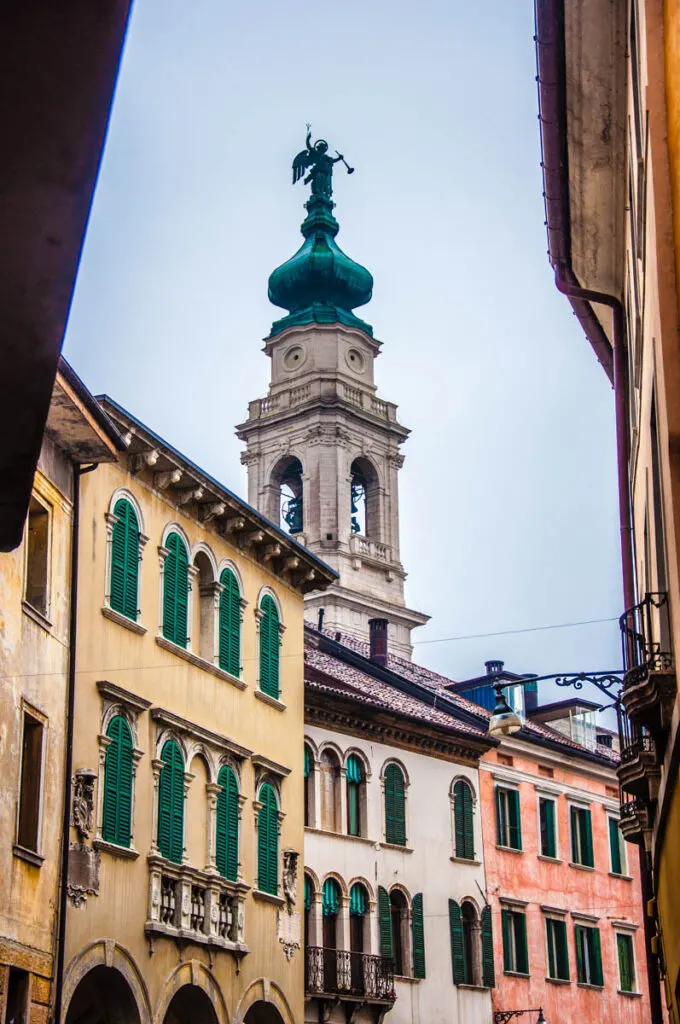
Often called the Gateway to the Dolomites, Belluno is a very pretty city in Veneto, Italy.
Its historic centre stretches along the top of a steep hill. Belluno’s churches and buildings stand against the backdrop of the majestic craggy peaks of the Dolomites.
Within an easy distance from Belluno, you will find a number of famous ski resorts, dozens of exciting hiking paths, and gorgeous medieval towns. The city itself – although small and very walkable in a day – offers a rich mix of history and art.
Here are my suggestions for the best things to do in Belluno, Italy:
- Palazzo Fulcis housing Belluno’s Civic Museum – this is a beautifully curated museum taking you on a journey through the history, the art, and the applied arts of Belluno and its province.
- Palazzo dei Rettori – this is the palace in which the Venetian rulers of Belluno lived and worked when the city was part of the Republic of Venice. A beautiful clock adorns the palace’s 16th-century tower.
- Duomo di San Martino – an imposing church dedicated to Belluno’s Patron Saint. Its bell tower is almost 72 m tall including the almost 5 m tall figure of an angel on its top. Inside the Duomo, you can admire a rich collection of religious art including a piece by Cesare Vecellio. He was a cousin of the worldwide famous Renaissance painter Titian – a native of the small town of Pieve di Cadore’ near Belluno.
- Piazza dei Martiri – an enormous square right in Belluno’s historic heart.
- Porta Dojona – a large gate that leads to Belluno’s most ancient part. Originally built in the 13th century, it was greatly enlarged during the Renaissance.
- Church of Santo Stefano – come to see the frescoes preserved in one of the church’s chapels as well as the works of art by Cesare Vecellio and followers of Titian.
- Borgo Piave – this is Belluno’s ancient river port. In the past, large rafts loaded with wood would head from here to Venice. Upon arrival, the wood was used to build the ships on which the commercial and military interests of the Republic of Venice depended greatly.
Belluno is a great destination to explore in Veneto, Italy. A weekend here offers you the opportunity to delve into history and art as well as to get out and about in the bosom of nature. With a small historic centre and landmarks that can be ticked off in a day, you can put a second day aside to enjoy a beautiful hike, to visit a centuries-old village, or to admire unique natural sights like Cadini del Brenton a short distance away from Belluno.
Belluno is a bit further away from the other cities of Venice. It is, however, a great starting point for an exploration of the Dolomites. So, make sure that you see it for yourself.
Travel Times by Train from Other Cities in Veneto: From Treviso – 1 h 24 mins – 1 h 51 mins. From Bassano del Grappa – 2 h – 2 h 19 mins. From Padua – 2 h – 2 h 47 mins. From Venice – 2 h 9 mins – 2 h 49 mins.
Train Station: Belluno
Where to Stay in Belluno: CasaZavi, Park Hotel Villa Carpenada
Tips: When in Belluno, don’t miss the city’s covered escalator. 93 metres long and rather steep, it takes you from the bottom to the top of the hill on which the historic centre stands.
The ride lasts about three and a half minutes and covers an elevation of 46 metres. The escalator is paid for but it’s a great experience, so do give it a try.
Map of the Cities of Venice and Veneto to Visit in Italy
Here is the map showing you the location of Venice and of the main cities near Venice to visit in Veneto, Northern Italy.
I made it using Google Maps. So, you can use this map of the ten major Venetian cities in Veneto just like any other Google map. You can zoom in and out, click to open the map in a separate tab, and click on the different pins to see their coordinates.
In the information box for each pin, I have inserted a link to local accommodation options on Booking.com. If you are researching places to stay, click on it to see what’s available for your travel dates.
You can also use this map to calculate distances and directions from any point in Veneto, Italy or abroad to any point in the ten main Venetian cities covered in this blog post. You can also zoom in and explore the urban plan of any of these ten cities. This way, you can make your own itinerary to follow during your visit.
If you want, you can share this map of the cities of Venice and Veneto on social media, too.
Here are the main cities in Veneto, Italy included in this map:
1. Venice 2. Verona 3. Padua 4. Vicenza 5. Treviso 6. Rovigo 7. Chioggia 8. Bassano del Grappa 9. Schio 10. Belluno
Practical Tips about Visiting the Cities of Venice and Veneto in Italy
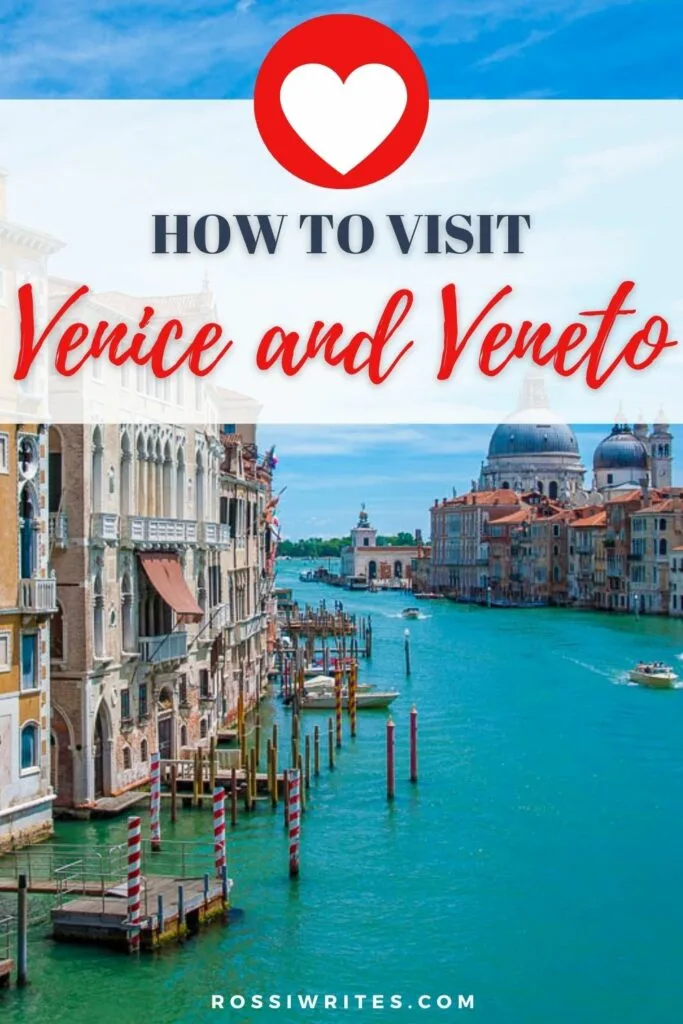
1. Where in Italy is Veneto?
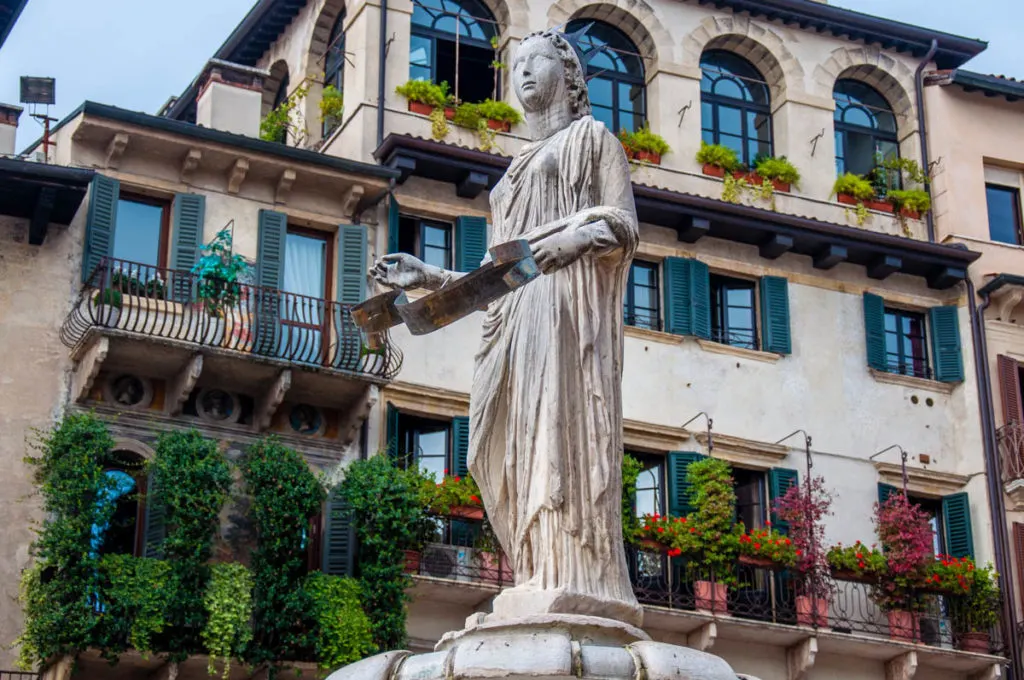
Veneto is one of Italy’s 20 regions. You will find it in the northeastern corner of the country. It stretches between the Dolomites to the north, the Adriatic seaside to the east, the Delta of the River Po to the south and the shores of Italy’s largest lake – Lago di Garda – to the west.
It borders the Northern Italian regions of Friuli Venezia Giulia and Trentino-Alto Adige to the north, Emilia-Romagna to the south, and Lombardy to the west.
Veneto’s capital is the city of Venice. The biggest city here is Verona.
Here is a map showing the exact location of Veneto in Italy and Europe. You can zoom in and out to see the geographical details that interest you.
2. How to Reach Veneto, Venice, and the Other Venetian Cities Here?
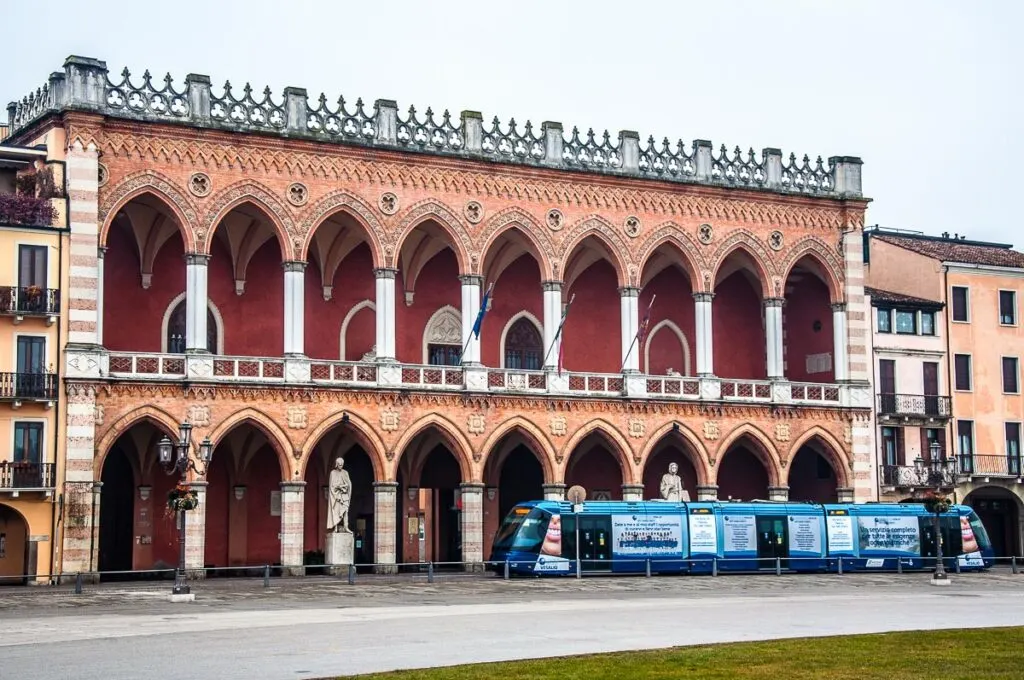
Veneto and its cities are very easy to reach from anywhere in Italy and Europe. Some of Italy’s most important airports are here. Plus, a well-structured railway system connects the region to all major destinations in Italy and many large European cities.
High-speed motorways and a dense network of regional roads help you get anywhere you want to go – from the main Venetian cities to the small villages in the mountains.
Here are a few more details to make your travel planning even easier:
How to Reach Veneto by Air
Three of Veneto’s main cities have large international airports served by many low-cost and national airlines. These are:
- Veneto Marco Polo Airport
- Treviso Airport Antonio Canova
- Verona Villafranca Airport
In addition, the cities of Venice and Veneto are very easy to reach from several other airports in Northern Italy like Bergamo Orio al Serio Airport, Bologna Guglielmo Marconi Airport, and Trieste Airport.
Have a look at these three blog posts which list the major airports in Northern Italy. They explain in some detail which cities here they are most convenient for:
- 11 Major Airports in Northern Italy (With Map, Nearest Cities, and Public Transport Options)
- 5 Best Airports for Venice, Italy (With Transfer Options and Travel Times)
- 8 Best Airports for Lake Garda or How to Reach Quickly by Plane Italy’s Largest Lake
How to reach Veneto by Train
Veneto and the Venetian cities also enjoy excellent connections by train to the largest cities in Italy. One of the most important Italian railway lines crosses the region. It connects Turin and Venice with stops in Milan, Brescia, Verona, Vicenza, and Padua along the way. Served by high-speed trains, it allows for fast and comfortable travel.
Venice and some of the Venetian cities are also connected by train to Innsbruck and Vienna in Austria, Munich in Germany, and Paris in France.
To check train travel times and buy tickets in advance, I use Omio. It shows prices and travel times for all available types of trains in Italy irrespective of the company that runs them. This way I can compare costs and times of departure and arrival.
How to Reach Veneto by Car
Make full use of Italy’s high-speed motorways. They are paid for via tolls at toll booths along the way but are worth every eurocent as they make travelling across Italy a quick and easy experience.
Here are three motorways running through Veneto:
- Autostrada A4 (also known as La Serenissima after the moniker of the historic Republic of Venice) – it connects Turin to Milan to Venice to Trieste.
- Autostrada A13 – it connects Bologna to Ferrara to Rovigo to Padua.
- Autostrada A22 (also known as Autostrada del Brennero) – it connects Modena to Mantua to Verona to Trento to the Brenner Pass.
This helpful website will give you an estimate of how much the tolls are going to cost depending on your points of departure and arrival.
If you need to rent a car for your stay in Veneto and Italy, click to check the latest offers and prices by Europcar.
3. How to Travel Between Venice and the Venetian Cities in Veneto, Italy?
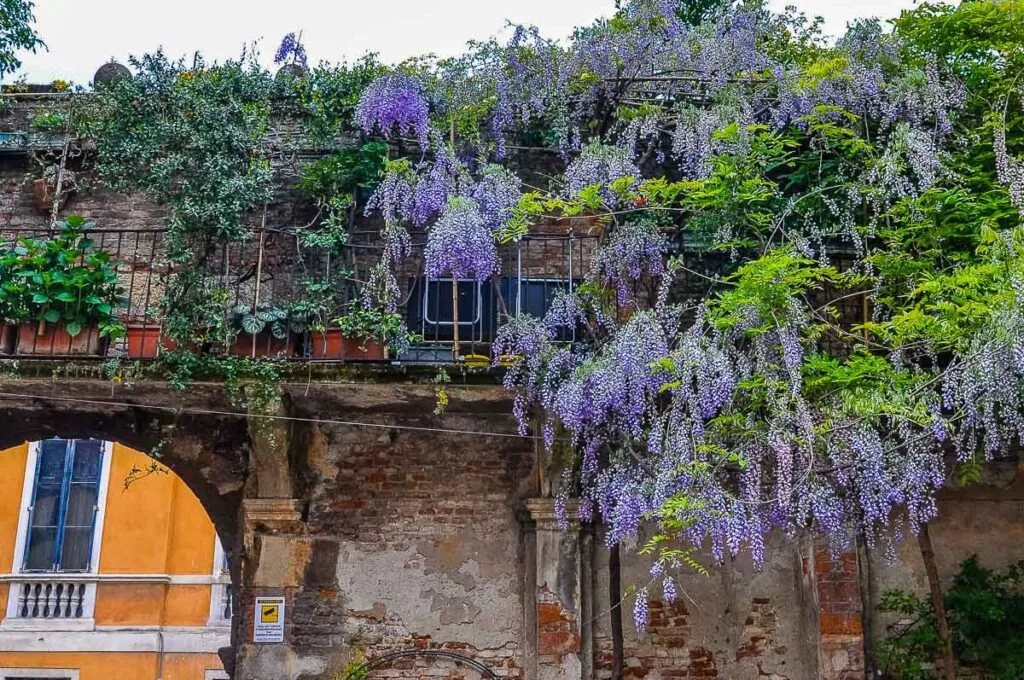
Train travel is quick, easy, and generally inexpensive in Veneto, Italy. For shorter distances, for example Venice to Padua or Padua to Vicenza, make sure that you use the fast regional trains (treno regionale veloce), as they are quick and inexpensive.
For longer distances, for example, Verona to Venice, consider booking a ticket in advance for the high-speed trains here (Frecciarossa, Frecciabianca or ItaloTreno). The earlier you buy it the cheaper it will be. In any case, check also the travel times of the fast regional trains as you may prefer to pay a price that is two to three times cheaper and travel just a bit longer.
Again, have a look at Omio. It shows prices and travel times for all available types of trains in Italy irrespective of the company that runs them.
Otherwise, you can consult these blog posts for specific details about travelling between Venice and the cities of Veneto:
- Venice to Padua – The Best Day Trip in Italy (With Travel Tips and Sights to See)
- Venice to Verona – An Easy Day Trip in Italy You Need to Take (With Travel Tips and Sights to See)
- Verona to Venice – An Unmissable Day Trip in Italy (With Tavel Tips and Sights to See)
- 3 Easy Ways to Tavel from Verona to Lake Garda in Italy
- 3 Easy Ways to Travel from Venice to Lake Garda in Italy
Alternatively, consider booking an organised day trip. Here are some great options to consider:
4. Where to Stay in Venice and the Venetian Cities?
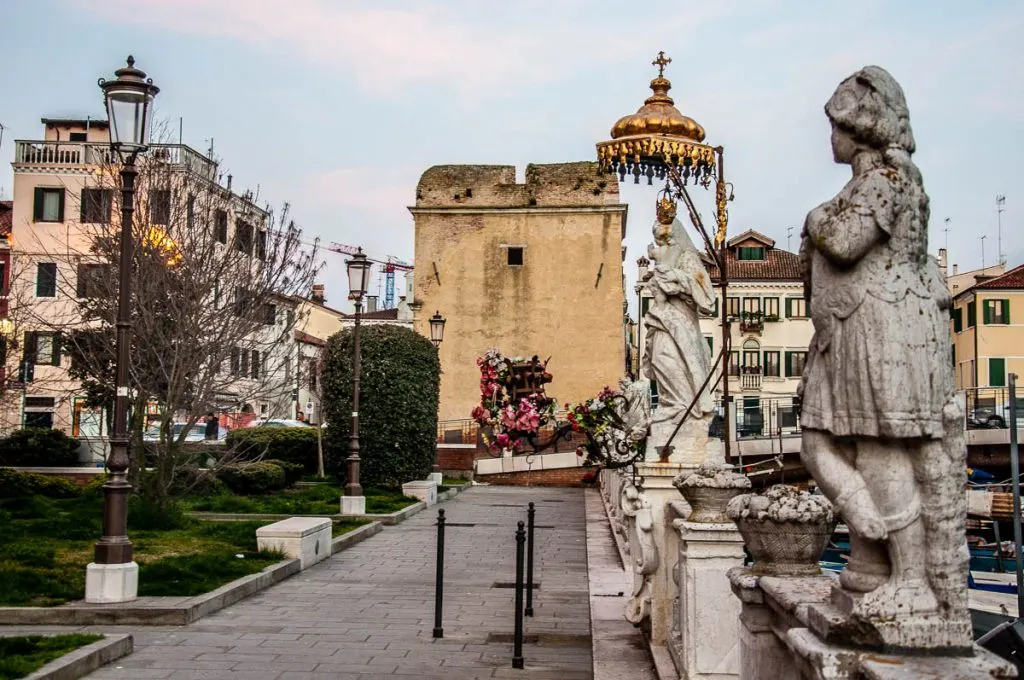
You can find all sorts and types of accommodation in and around the cities of Venice and Veneto in Italy to suit any budget. From luxury hotels in centuries-old palaces to cozy B&B’s in historic buildings, there is something for everyone.
For ideas about the types of accommodation available in Veneto in particular and Italy in general, have a look at this blog post:
I usually prefer to book all my accommodation through Booking.com. It gives me many different options in terms of budget and location and I can also read and compare reviews left by real people. Click to see all available places to stay in Veneto, Italy.
If you need some visual help in terms of precise locations and price range, have a look at this map. It gives you a quick idea of the prices and whereabouts of the many hotels and privately rented flats and houses you can book for your stay in the cities of Venice and Veneto in Italy:
5. What Tours and Activities to Enjoy in the Cities of Venice and Veneto in Italy?
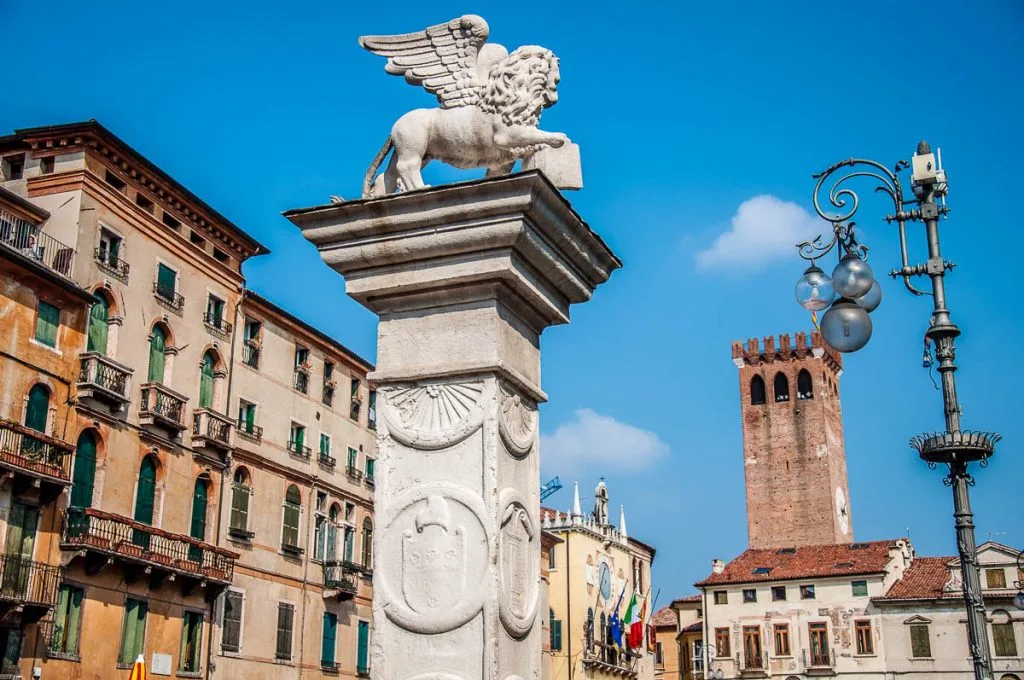
Do you enjoy exploring new places with the help of an expert local guide? Then booking an organised tour or activity during your time in Veneto, Italy is a great idea. It will give you a chance to delve in a structured manner into everything that this exciting Italian region and its Venetian cities have to offer. From history and art to delicious food and wine, you can experience the best of Veneto and Venice in a short amount of time.
Have a look at this blog post for the best tours you can book specifically in Venice:
Alternatively, consult Viator.com and Tiqets.com – two tours and tickets search engines – for the best options in terms of guided visits, group tours, and private explorations in Veneto.
6. What Else to Do in Veneto, Italy?
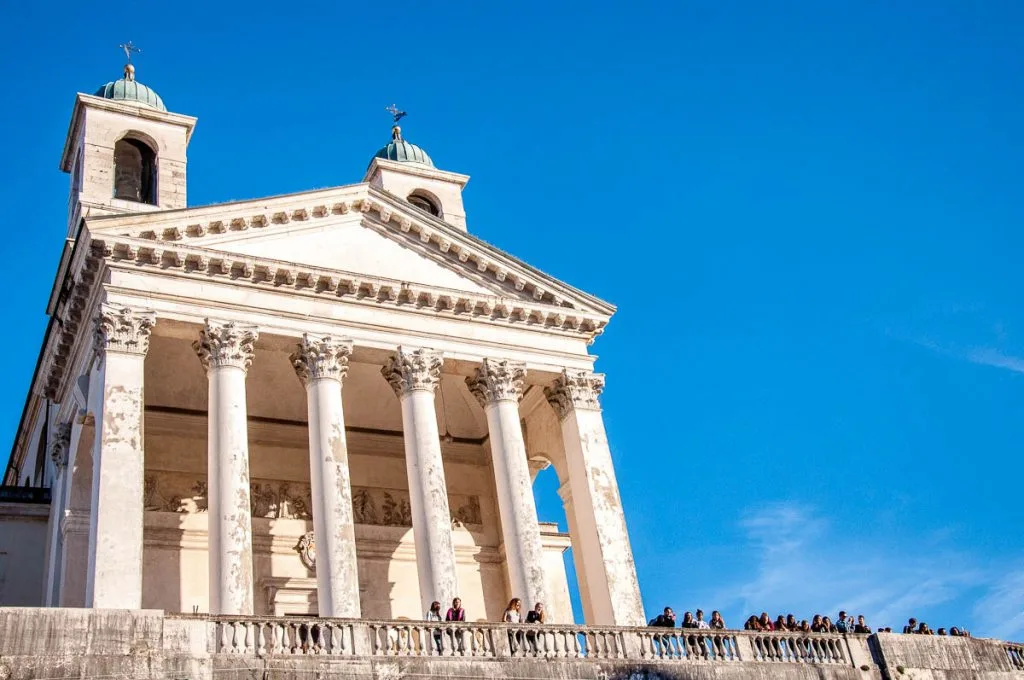
Veneto is not all about Venice and the large Venetian cities here. There is so much more to do and enjoy in this beautiful corner of Northern Italy. From small picturesque villages to medieval walled towns, from sights of natural beauty to lakes and the Adriatic seaside, the choice of things to see and experience is nearly endless here.
Have a look at these blog posts for some great suggestions for things to get up to during your stay in Veneto, Italy:
- Top 15 Places to Visit in Veneto, Italy – The Ultimate Guide
- 8 Most Beautiful Villages to Visit in Veneto, Italy
- 31 Prettiest Small Towns to Visit in Veneto, Italy (With Map and Practical Tips)
- 30 Days of Adventures in Veneto, Italy
- Gorgeous Lakes in Veneto, Italy You Have to See for Yourself (With Map and Useful Details)
- Hiking in Veneto: Sanctuary of Madonna della Corona, Cadini del Brenton and Cascate della Soffia, Lake Garda’s Tibetan Bridge, Rocca di Garda, Dante’s Hill, Grotta Azzurra di Mel, Family-Friendly Walks and Hikes
7. What to Do in Veneto, Italy with Kids?
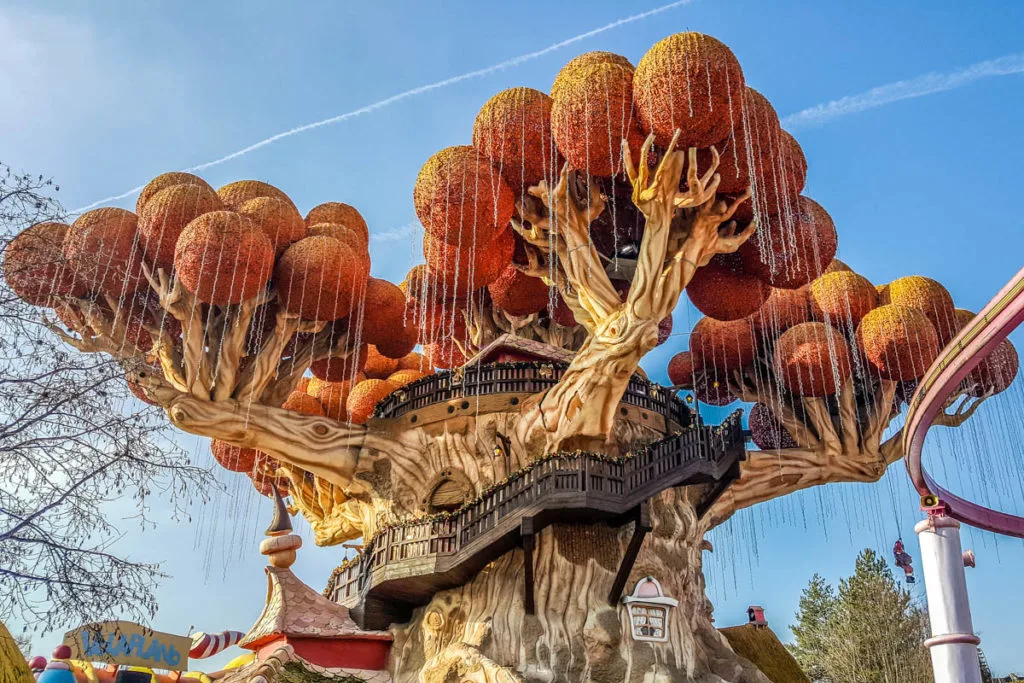
The Northern Italian region of Veneto truly is a great place to visit with children. There is so much to see and do here with kids of any age that you all will be spoilt for choice.
From Italy’s largest theme parks to medieval castles, from cooking classes to sprawling beaches, there is something here to satisfy even the most demanding child (or adult!).
Have a look at these blog posts. They will give you lots of ideas on how to structure your family time during your stay in Veneto, Italy:
- 19 Best Theme Parks at Lake Garda, Italy (With Maps and Practical Tips)
- 21 Best Things to Do in Italy with Kids – The Ultimate Family Travel Guide
- Lake Garda with Kids or the 11 Best Things to Do at Italy’s Largest Lake for Families
- Hiking in Italy
In Conclusion
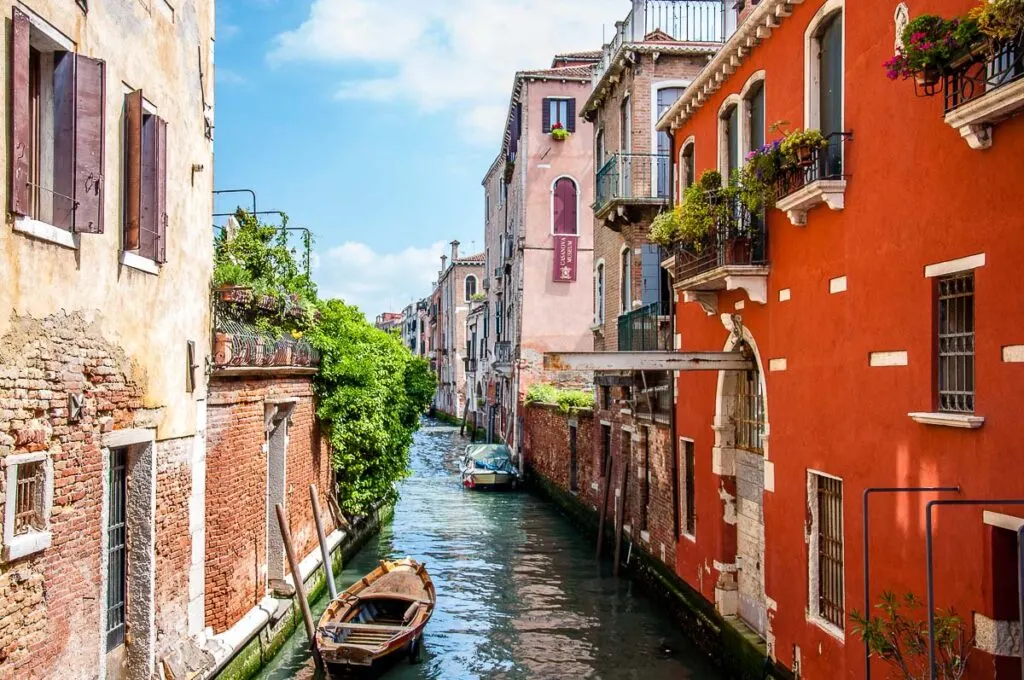
Veneto is that Northern Italian region that over thirty million people flock to every year eager to experience the beauty of its capital – the magical city of Venice.
Yet, Venice is not the only gem in Veneto’s crown!
This beautiful corner of Italy is dotted with several large and important from the point of history and art cities which are a great standalone destination. From Verona to Padua and from Vicenza to Chioggia, you will find many intriguing and beautiful cities here to visit and have wonderful experiences in.
For many centuries, these cities were part of the Republic of Venice – a large and powerful state that held a tight reign over the commerce in the Mediterranean Sea and dominated large swathes of land in Northern Italy and further beyond. As such, each of these cities has Venetian-inspired architecture and art cleverly mixed with its own local particularities.
Visiting these Venetian cities nowadays is a great way to spend a truly exciting Italian holiday.
So, in this blog post today, I shared with you why Venice and the cities of Venice are great to visit in Veneto, Italy. For each one of them, I included a short overview and a shortlist with its most famous sights. There is also a map showing the exact locations of the cities of Venice and a section with practical tips to make your travel planning as smooth and enjoyable as possible.
I hope that all this first-hand tried and tested information about Veneto in Italy will come in very useful.
Enjoy your time in the cities of Venice and Veneto!
Now, get ready quick for your visit to the cities of Venice in Veneto, Italy!
- Consult these guidebooks.
- Buy plane tickets to Italy.
- Book train tickets, bus tickets or rent a car.
- Research accommodation.
- Select tours and activities.
More Helpful Veneto Info for You
Veneto: Top Places to Visit, Unique Adventures, Most Colourful Places, Mysterious Places, Most Beautiful Lakes, Reasons to Visit
Veneto’s Small Towns and Villages: Prettiest Small Towns, Most Beautiful Villages, Cittadella, Malcesine, Torri del Benaco, Punta di San Vigilio, Este, Montagnana, Campo di Brenzone, Borghetto sul Mincio
Venice: Major Landmarks, Essential Tips, Hidden Gems, One Day Itinerary for Art Lovers, Nearest Airports, Boats in Venice, Haunted Venice, Day Trips from Venice, Arco del Paradiso
Verona: Things to Do in One Day, Day Trips from Verona
Padua: Things to Do in One Day, Facts About Padua, Reasons to Visit, Day Trips from Padua
Vicenza: Things to Do, Must-See Museums, The Beauty of Vicenza, Day Trips from Vicenza
Hiking in Veneto: Cadini del Brenton and Cascate della Soffia, Lake Garda’s Tibetan Bridge, Rocca di Garda, Dante’s Hill, Grotta Azzurra di Mel, Family-Friendly Walks and Hikes, Sanctuary of Madonna della Corona
More Helpful Italy Info for You
Best of Italy: Italy Gift Guide, Italian Piazzas, Italian Markets
Italian Food: Best Italian Food Gifts, Cheap Italian Food, Rules of Italian Breakfast, Italian Breakfast Foods
Italian Coffee: Italian Coffee Culture, Italian Coffee Drinks, History of Coffee in Italy
Christmas in Italy: Fun Facts, Things to Do, Italian Nativity Scenes, Panettone, Christmas Guide
Northern Italy: Best Cities to Visit, Major Airports, Reasons to Visit
Lake Garda: Best Towns, Theme Parks, Nearest Airports, Travel Options, Lake Garda with Kids, Malcesine, Riva del Garda, Torri del Benaco
Lake Como: Things to See, Nesso
Lombardy: Best Cities and Towns, Brescia
Friuli Venezia Giulia: Venzone, Most Beautiful Villages
Emilia Romagna: Bologna, Ravenna, Comacchio, Most Beautiful Villages
Marche: 6 Reasons to Visit, Gradara, Frasassi Caves, Temple of Valadier
Thank you for reading! Please, leave me a comment, pin the images or use the buttons right at the top and at the end of this blog post to share it on social media.
For more useful information like this, please, like my blog’s page on Facebook and subscribe to my strictly no-spam newsletter.
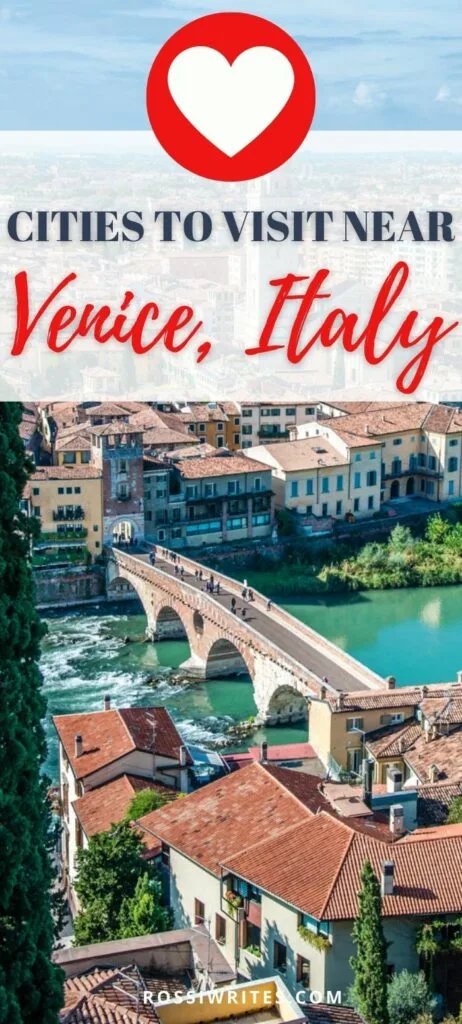
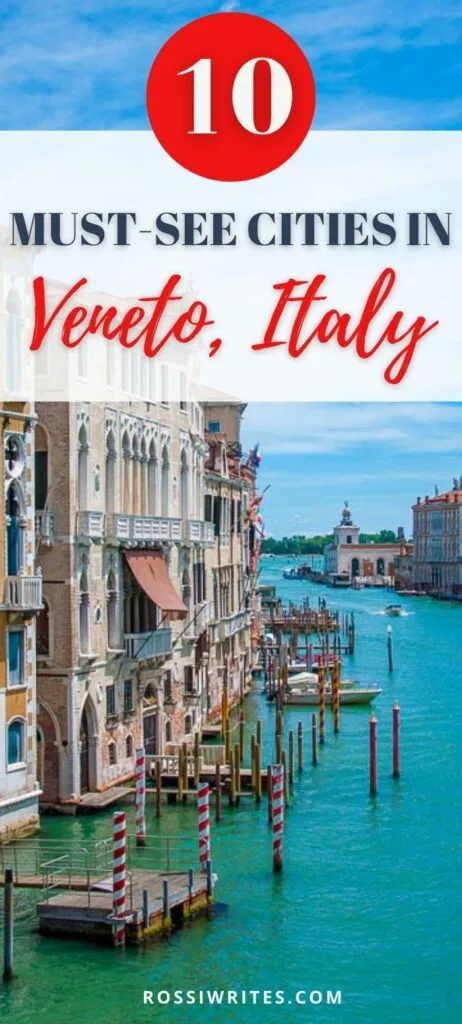

Carol
Tuesday 15th of February 2022
What an exceptional and comprehensive survey of what Venice and the Veneto offers visitors! Gorgeous, thorough and enticing in every way! Congratulations on the scope and depth of this amazing work that makes a great case for the extraordinary treasures just beyond La Serenissima.
admin
Thursday 17th of February 2022
Thank you so much for your kind words! It took me a long time to put the information together coupled with many visits to each of the described places and countless of photographs taken of each landmark. I can only be happy if all this is of help to people planning to explore this absolutely beautiful corner of Italy.
Best wishes,
Rossi :)